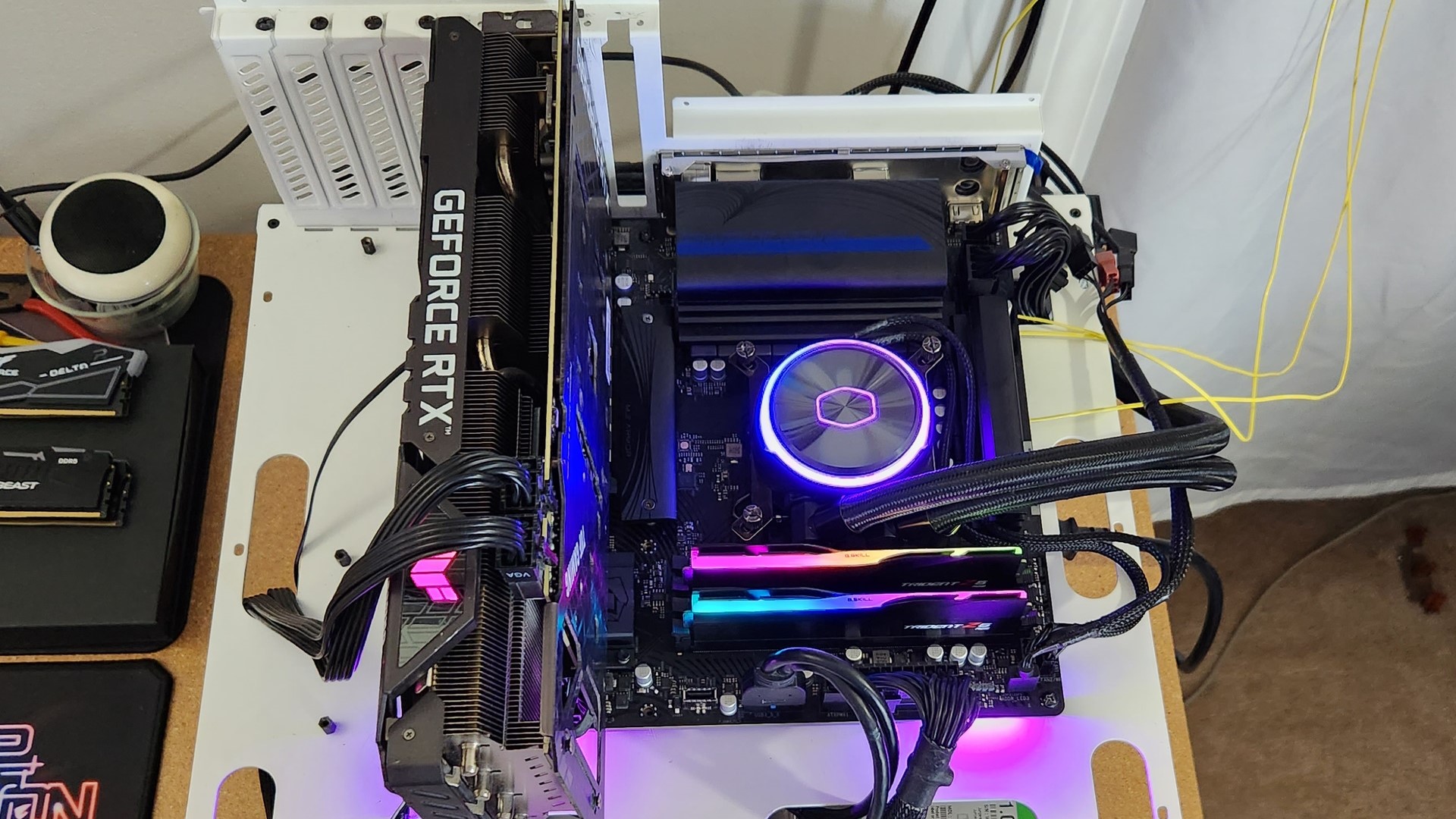
The ASRock B760M PG Riptide is a Micro ATX motherboard that supports the latest Intel 12th and 13th Gen Intel processors. Priced at just over $145, it offers a simple black-on-black appearance, with a blue strip on the VRM and a few RGB LEDs hidden under the right side of the board. You get two M.2 sockets and four SATA ports for storage, Realtek 2.5 GbE networking (Wi-Fi not included), memory support listed up to DDR5-7200+(OC), and a budget Realtek audio codec. Ultimately, it’s a full-featured option in the budget Micro ATX space.
The PG Riptide stacks up well against the competition on the hardware front. At this price and with this budget chipset, there’s not much that can go on these boards except for the basics, as the platform limits the potential for high-speed interfaces.
To keep the price point low, ASRock uses 12-phase VRMs for Vcore, and instead of using more modern (and costly) SPS MOSFETs, we see an old-school configuration using Hi and Low side ICs instead of combined as we’re used to on more expensive models. This isn’t ideal for high-end processors, but it did allow our Intel Core i9-13900K to run the Intel’s defaults, boosting up to 255W for a short time, then limiting itself to 125W and lower clocks. You won’t find PCIe 5.0 x4 slots, a high-end audio solution, or even 20 Gbps Type-C ports at this bargain basement price, but you can run the latest and greatest processors for the platform and DDR5 memory.
Performance-wise, The B760M PG Riptide is all over the map, as it follows Intel’s specifications. You get a full 255W for the processor, and then it ramps down off the turbo boost, limiting it to 125W. For a motherboard of this class, that’s to be expected, especially due to the paltry VRMs powering the processor. It competes with high-end boards in single-threaded applications or in shorter-running, heavily threaded applications. Gaming performance was above average, and Intel’s limits aren’t getting in the way of gaming. If you plan to drop in a high-end processor and utilize all the cores and threads, you’ll find a ceiling on performance compared to other boards that bypass Intel’s specs.
Below, we’ll dig into the details of the board and see if the PG Riptide finds its way onto our Best Motherboards list. Before we get into our testing and board details, though, we’ll start by listing the specifications from ASRock.
Specifications: ASRock B760M PG Riptide
Inside the Box of the ASRock B760M PG Riptide
Inside the retail box, above the motherboard, is a small handful of accessories. ASRock includes a manual, postcard, two SATA cables, screws for the M.2 sockets(2), and a case sticker. There isn’t much here, though the basics are covered.
Design of the B760M PG Riptide
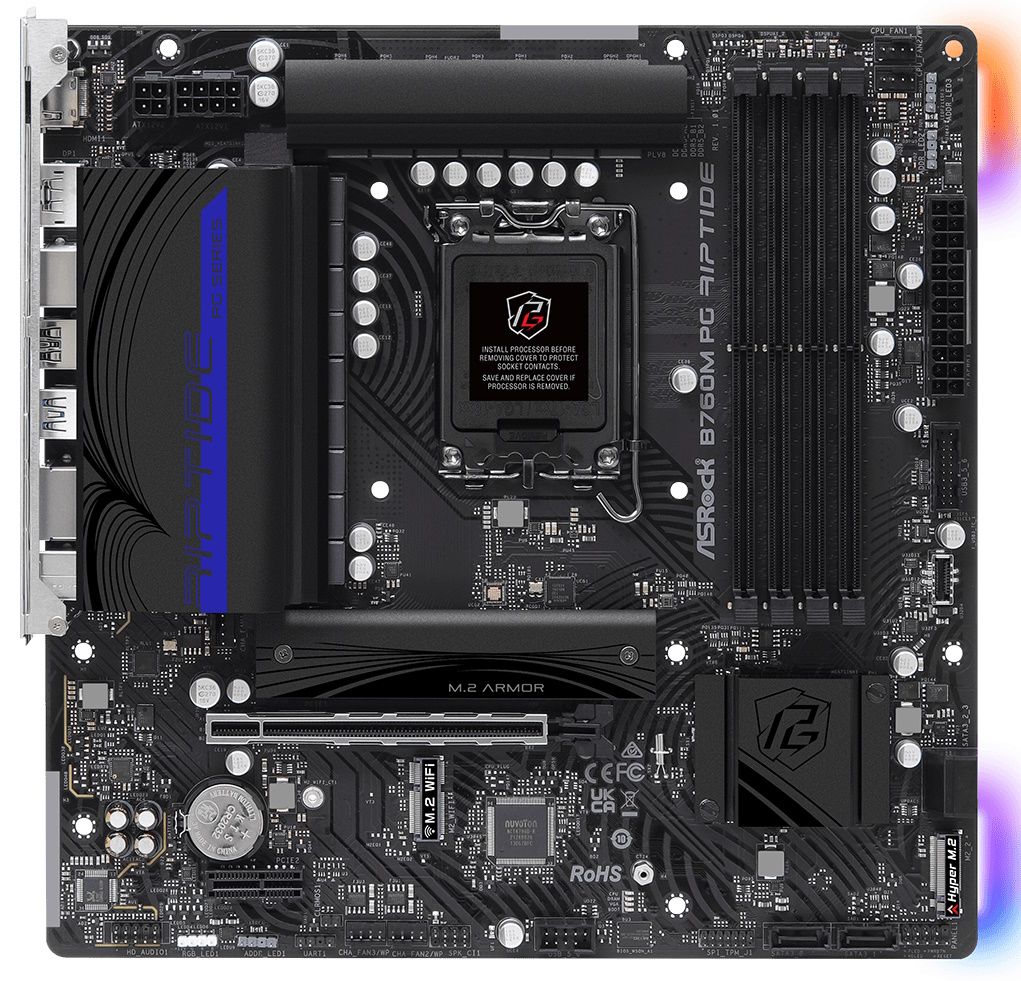
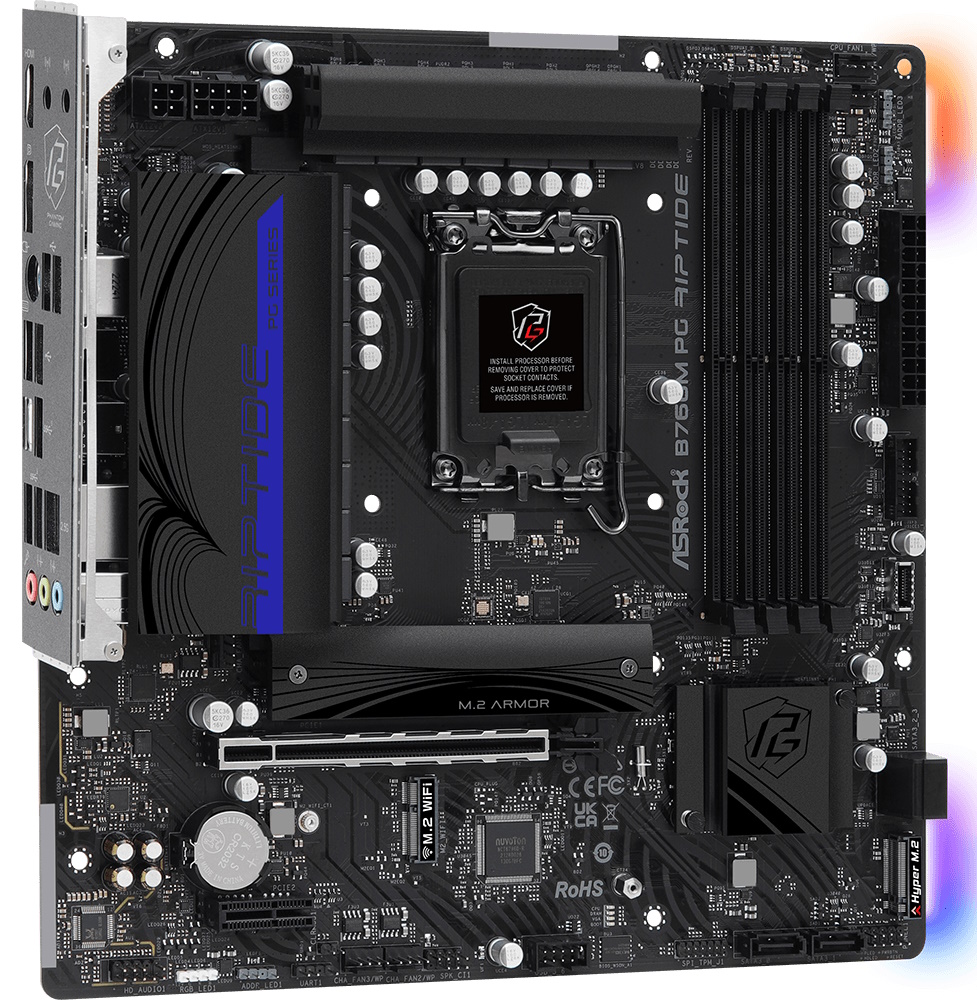
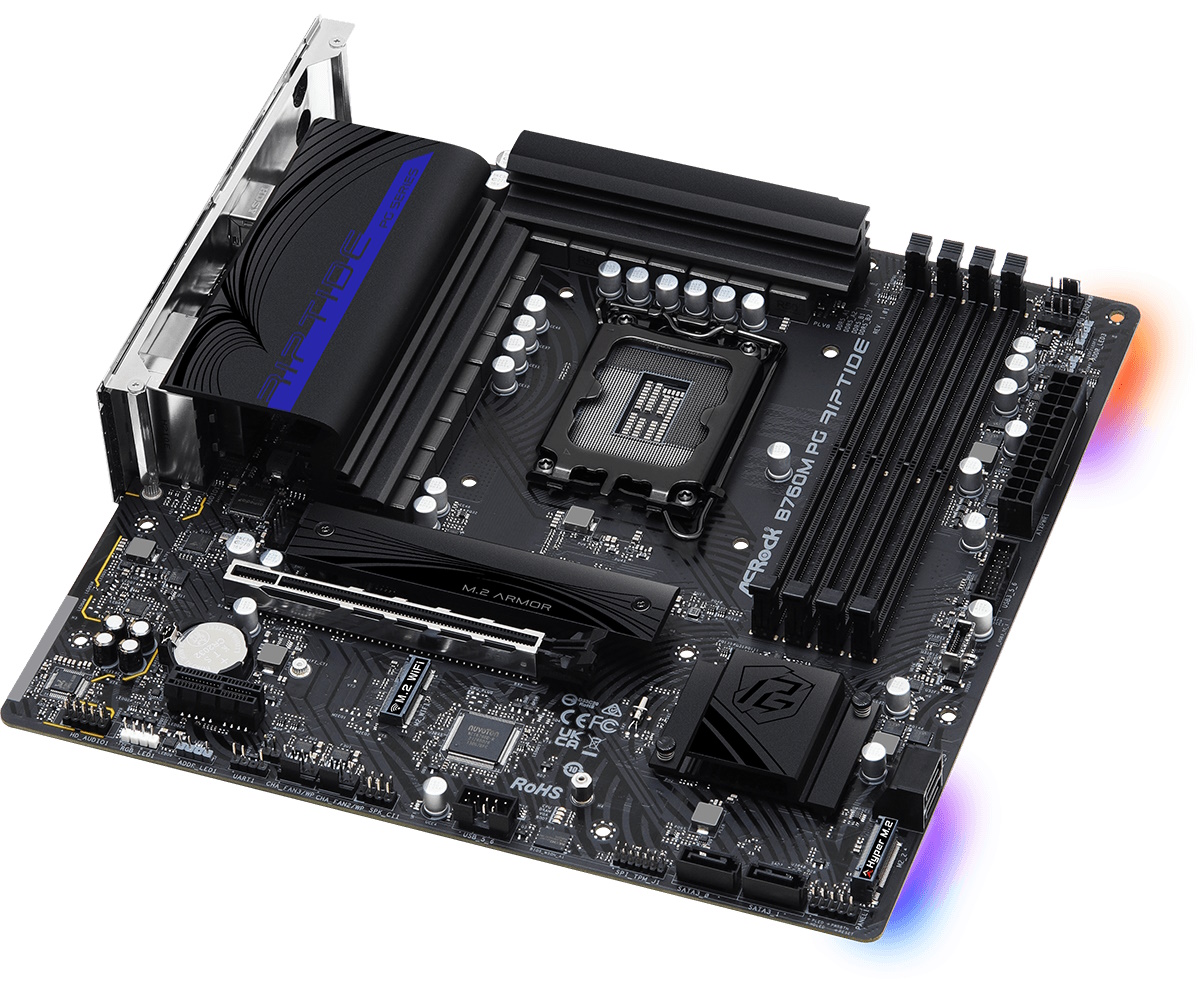
The B760M PG Riptide comes with a matte-black PCB with black slots, sockets, and heatsinks. The only color is a blue/purple strip with some branding on the left VRM heatsink. The board and heatsink have some lines stenciled on, but it's tough to see the design as they are barely lighter than the board itself. If you’re looking for RGB lighting, the Riptide has you covered with two zones with three LEDs each on the right edge, at the top and bottom. The RGBs are bright and the color is saturated, which makes for a nice glow from below the board, lighting up the inside of your chassis. Overall, it’s a good-looking motherboard for the price, but certainly not a showpiece.
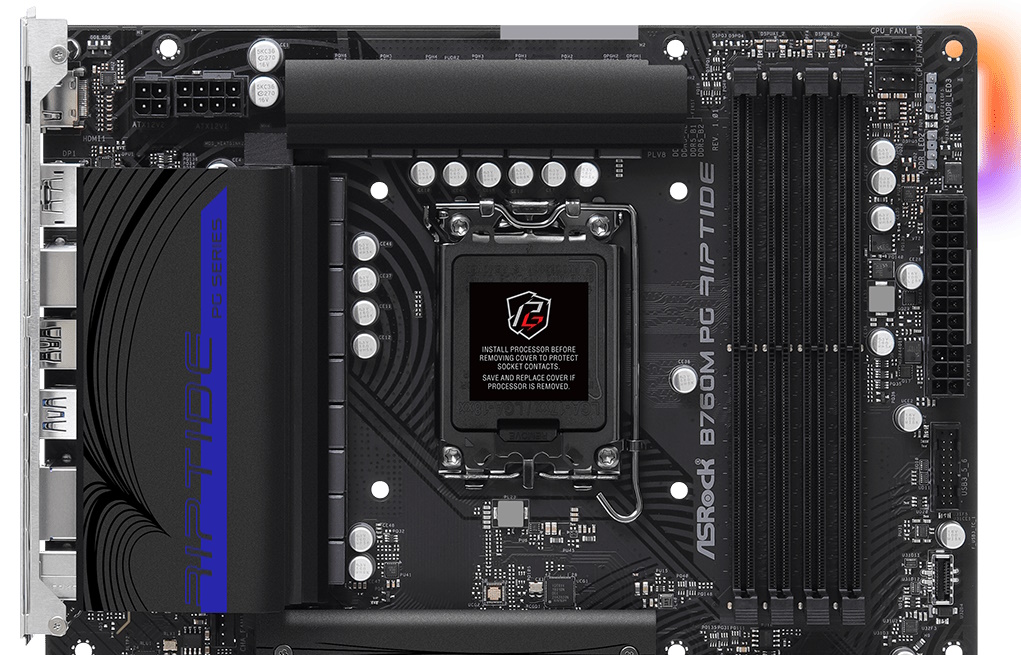
In the upper left corner of our budget board, the first thing we see is the 8-pin (required) and 4-pin (optional) EPS connections to power the processor. Next, we get a closer look at the VRM heatsinks. The left heatsink is the larger of the two, reaching out over the rear IO area and covering some of those unsightly Rear IO bits. On top, the Riptide PG Series branding, in that deep blue/purple color, matches the PCB’s design/patterns.
Moving past the socket area, we find four DRAM slots with locking mechanisms on both sides. ASRock lists support up to DDR5-7200, but as always, your mileage may vary depending on the kit used. Your best chance of success in these fast kits is to stick with the QVL list.
Just past the DRAM slots in the upper-right corner are the first two (of four) 4-pin fan/pump headers. Each header supports PWM and DC-controlled devices. The CPU fan (CPU_FAN1) supports up to 1A/12W and the rest of the headers support 2A/24W. I’d like to see another fan header or two, but you can piggyback a couple of fans on the headers. Just be sure not to overload them as it could damage your board.
Next, we run into two (of four) RGB headers. In this case, there are two 3-pin ARGB headers with an additional ARGB header and a single 4-pin RGB header along the bottom edge. The Polychrome application controls the RGBs and worked well in our limited use syncing with the other products.
Continuing down the right edge, we run into the 24-pin ATX connector to power the board, a front panel USB 3.2 Gen 1 (5 Gbps) connector, and a USB 3.2 Gen 2 (10 Gbps) Type-C header for the front panel.

Power delivery on our PG Riptide is configured as 14 total phases, with 12 dedicated to Vcore, just like the PG Sonic we recently reviewed (and its twin, the Steel Legend). Power comes from the 8-pin EPS connector and heads down to the Richtek RT3628AE 9-channel PWM controller. Next are the 12 VRMs dedicated to Vcore set up using a Teamed configuration. The VRMs don’t utilize the newer MOSFETs that combine Hi and Low sides, so each phase has two ICs. There isn’t a lot of power available, but it handled our Intel Core i9-13900K following the Intel specs. Not sure I’d let the system run without these limits for long, however. At least not without active cooling on the power delivery.

On the bottom of the board, on the left side, we see the Realtek ALC897 audio codec, four capacitors dedicated to audio, and a visible audio separation line designed to minimize EMI. This isn’t the newest or best audio solution. However, many those prioritizing price over fancy features should find the output sufficient.
In the middle of the board, we see a full-length PCIe slot and an open-ended x1 slot. The top primary slot uses reinforcement to protect against shearing from heavy graphics cards. This slot connects through the CPU and runs at PCIe 4.0 x16, while the bottom x1 slot sources its lanes through the chipset and runs at PCIe 4.0 x1. Just below the top slot is a Key-e M.2 socket that supports 2230 Wi-Fi/BT PCIe modules using the Intel CNVio/CNVio2 protocols. Our board doesn’t come with one, but you can purchase one separately for $25 or less and easily add it if needed.
Moving on to storage, our board has two M.2 sockets. The top socket (M2_1), under the heatsink, connects through the CPU with PCIe 4.0 x4 (64 Gbps) bandwidth. The other socket (M2_2) on the right edge does not have a heatsink and runs up to the same speed. Each supports up to 80mm devices. Four SATA3 6 Gbps ports round out the storage options, with two located on the right edge and two on the bottom. If you’d like to use RAID, you can do so on the SATA ports (RAID0/1/5/10), but RAID support for the M.2 sockets isn’t listed.
Across the bottom of the board are several exposed headers. You’ll find the usual, including additional USB ports, RGB headers, and power/reset buttons. Below is a complete list from left to right.
- Front panel audio
- 4-pin RGB header
- 3-pin ARGB header
- Clear CMOS jumper
- (2) System Fan headers
- Speaker header
- USB 2.0 header
- TPM header
- (2) SATA3 6 Gbps ports
- System panel header

The rear IO plate on the B760M PG Riptide comes preinstalled to the motherboard, which is a nice touch at this price. It sports a black theme with white labels along with Phantom Gaming branding. There’s a total of eight USB ports scattered across the rear IO. You get one USB 3.2 Gen 2 (10 Gbps) Type-C port, three USB 3.2 Gen 1 (5 Gbps) ports, and four USB 2.0 (480 Mbps) ports. For video, the PG Riptide has HDMI and DisplayPorts for those using the integrated graphics on the processor. Last up are the 2.5 GbE port, a PS/2 port for the keyboard and mouse, and three 1/8-inch outputs that comprise the audio stack.
MORE: Best Motherboards
MORE: How To Choose A Motherboard
MORE: All Motherboard Content
Firmware
ASRock’s firmware for B760 keeps the same general format as we saw in the Z790 model. The major changes are the updated options/functions for Raptor Lake CPUs. The PG Riptide sports the black and red color scheme of the Phantom Gaming brand. Like the other boards, you start in Easy Mode, which is mostly informative but lets you change a few options (XMP, profiles, boot order, Fan-Tastic Tuning, etc.). Advanced mode displays headings across the top with details below. Here you can tweak everything that can be tweaked, as ASRock includes every option you can think of. Overclocking is easy, with most options on the same page, although some power options are in a different section. It’s a logical layout. The movement is smooth, and it’s easy to read. No complaints from us about the ASRock firmware.


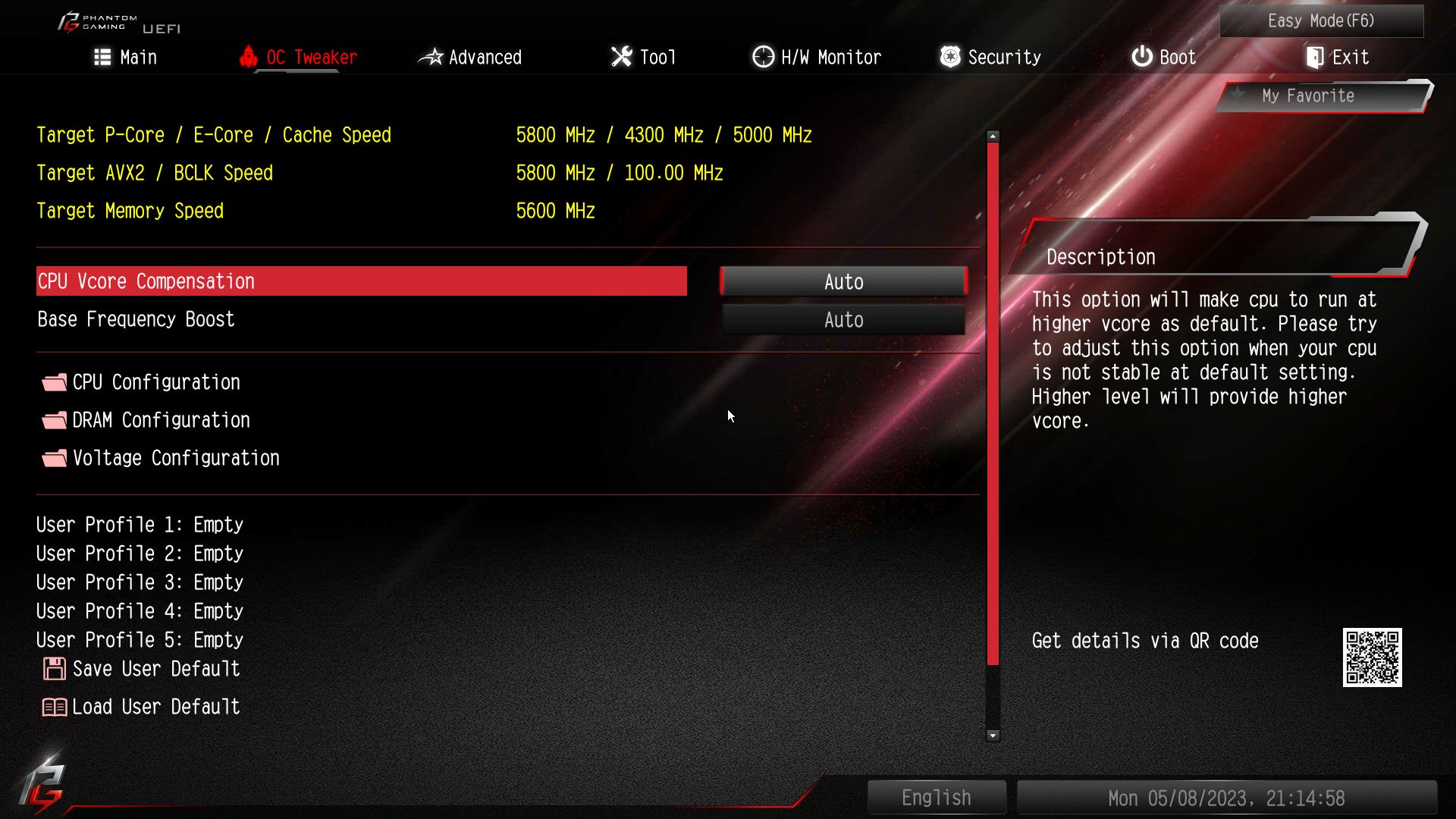
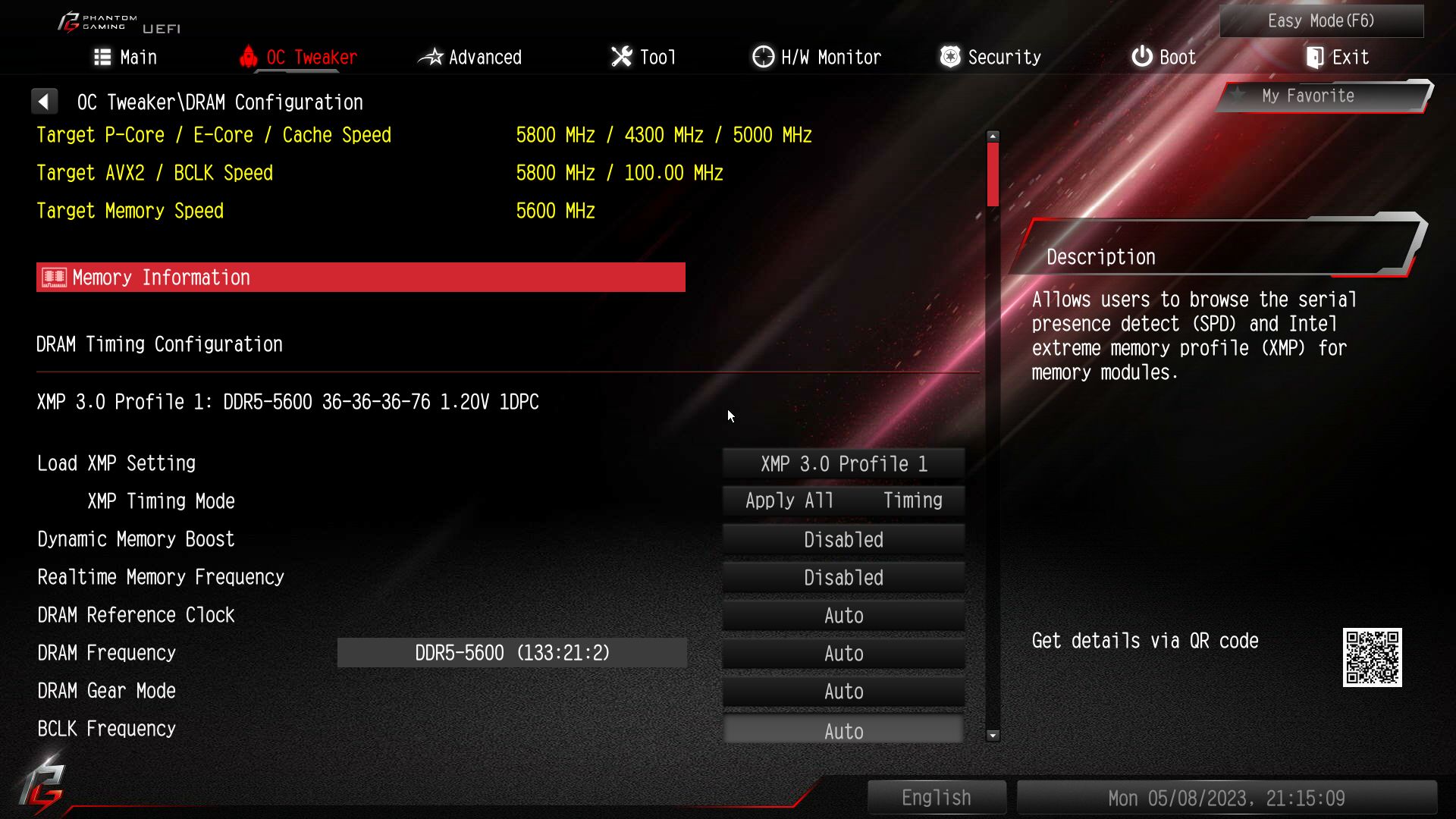
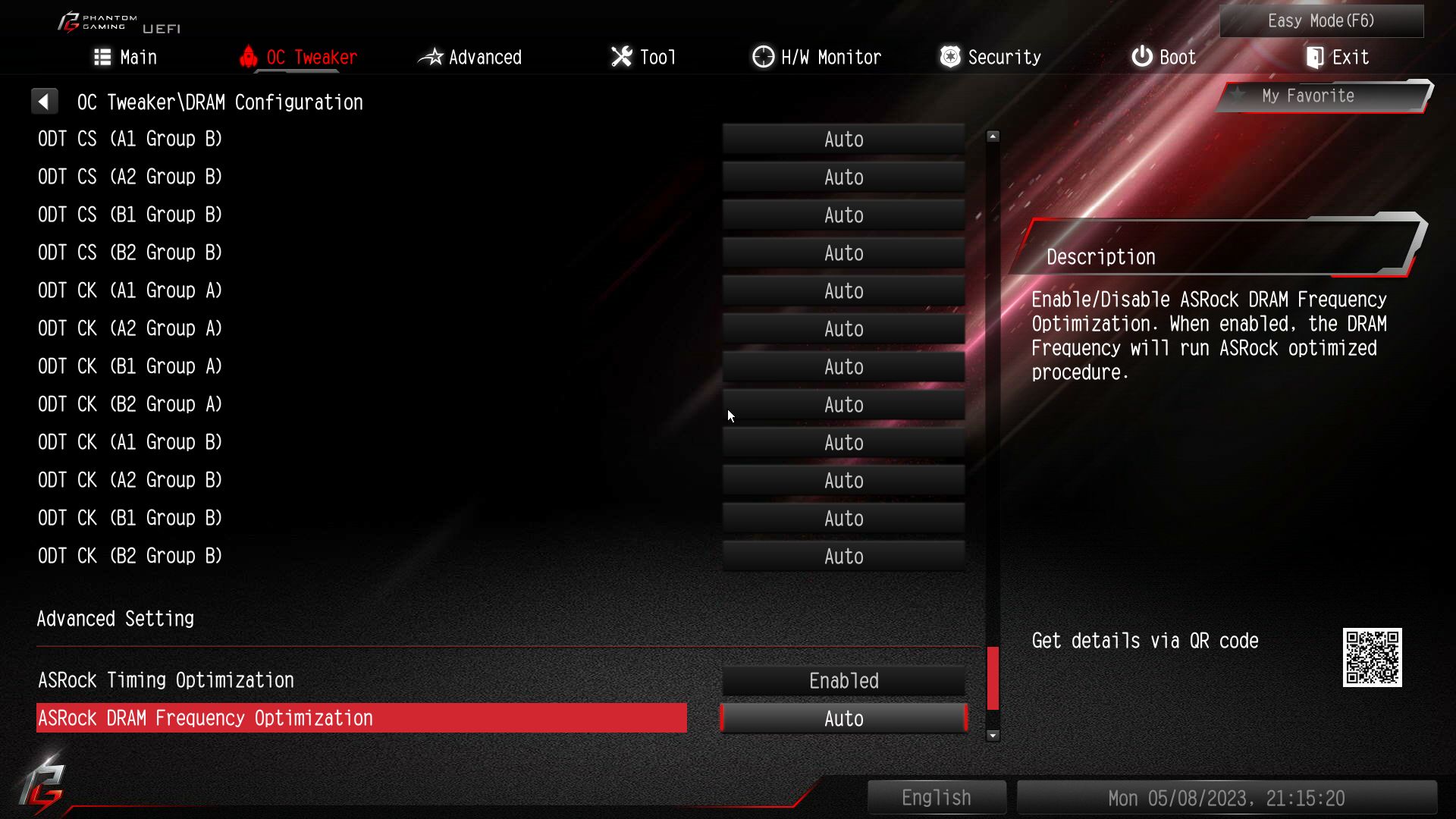
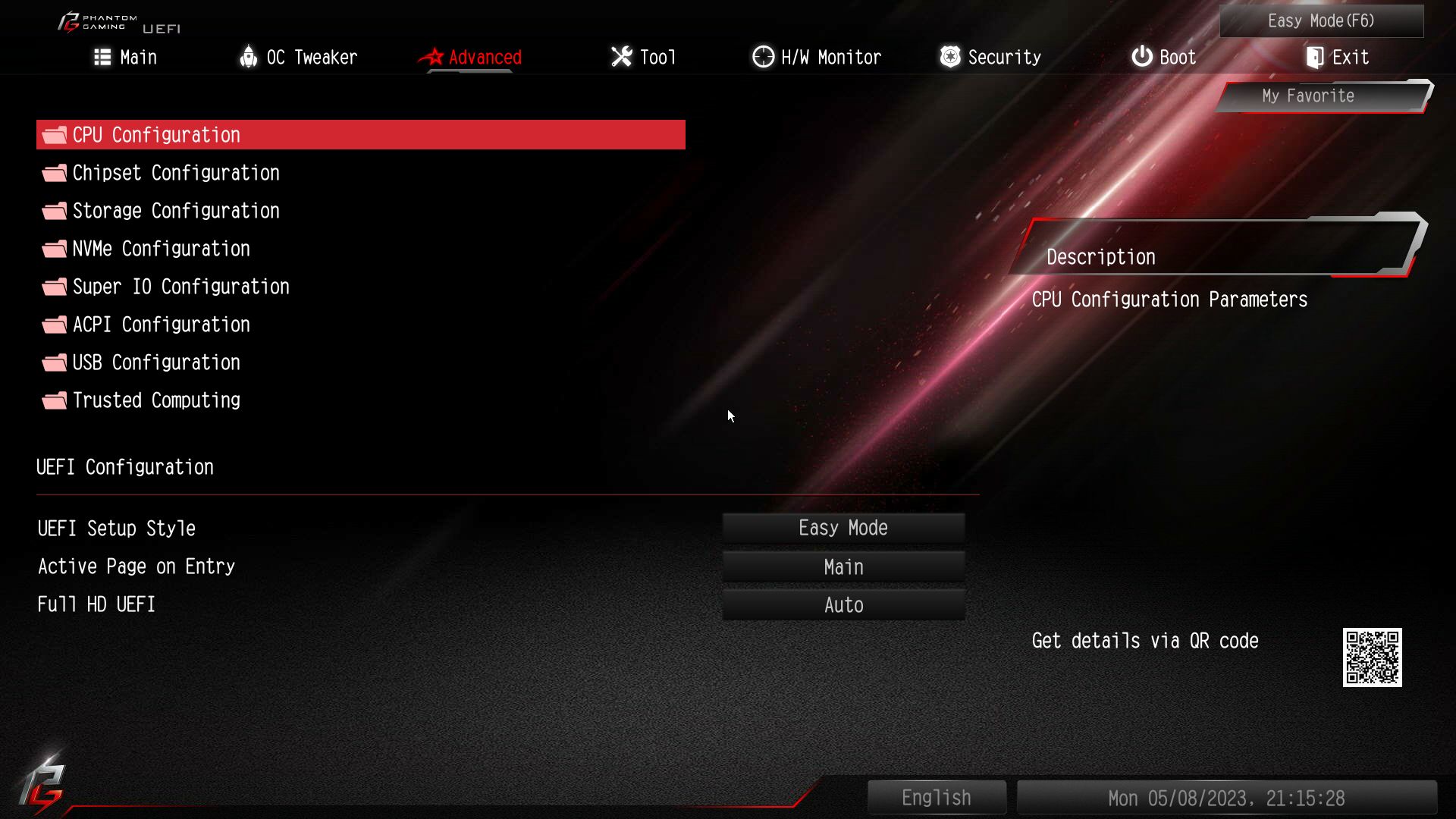


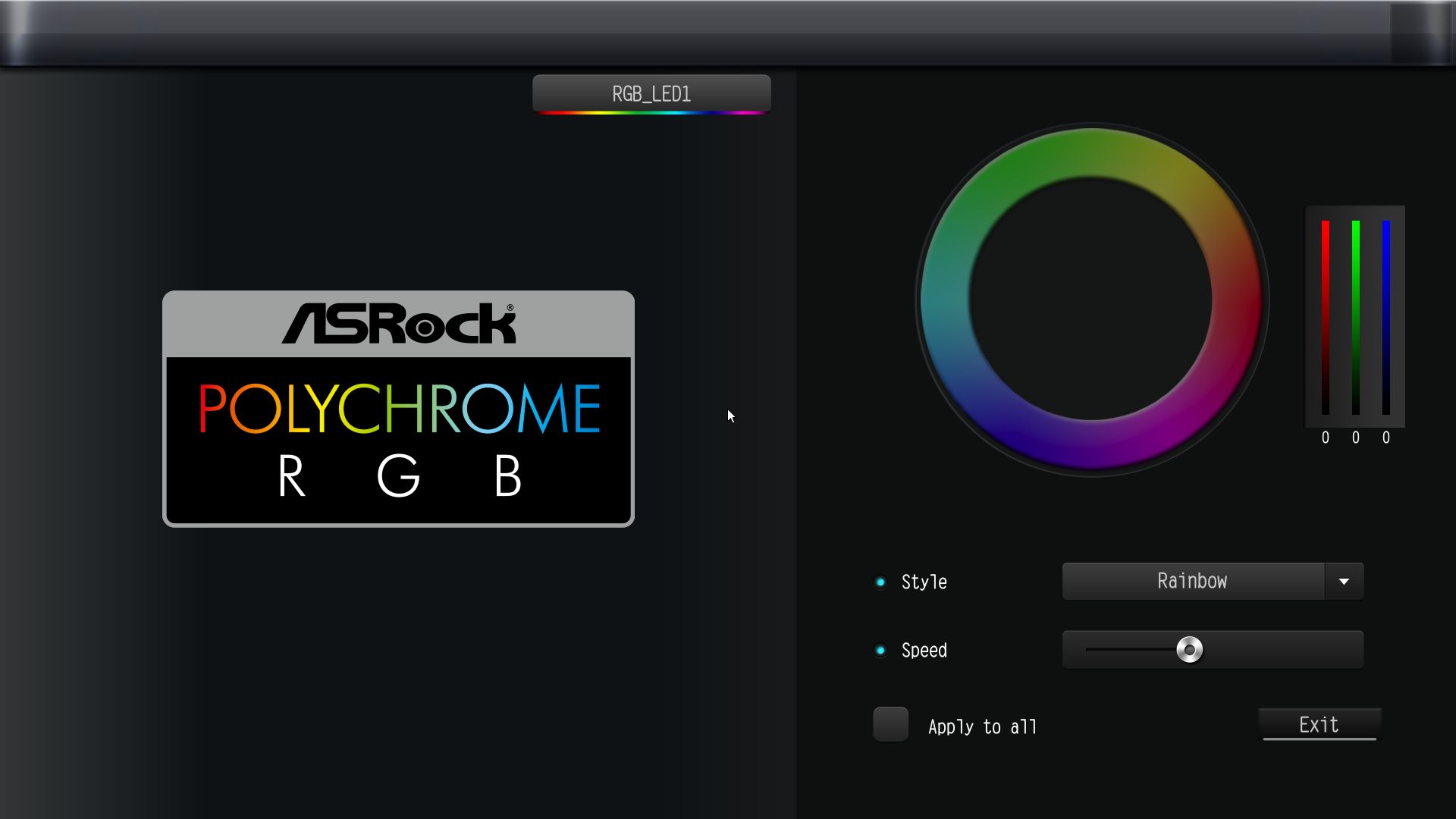

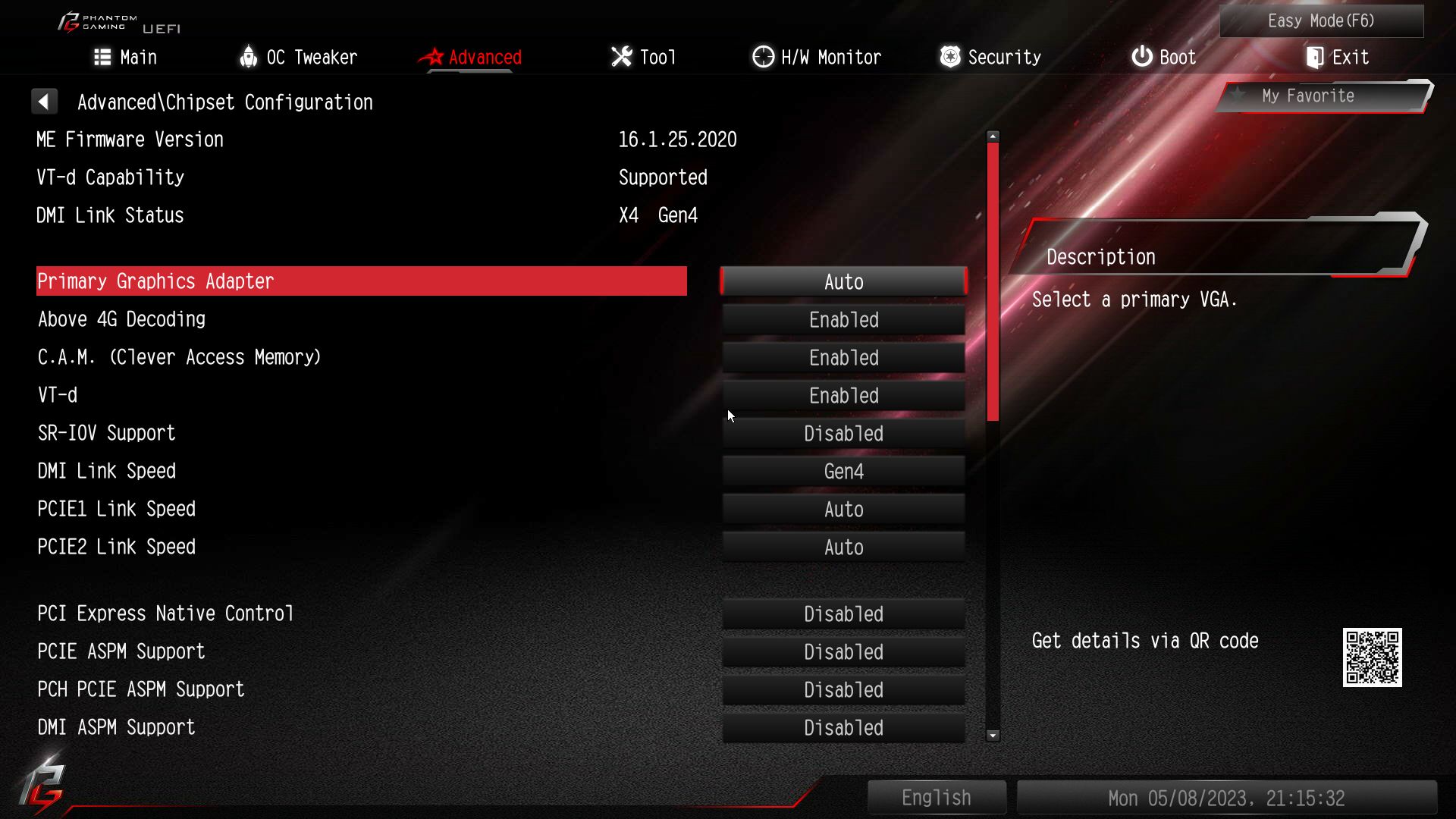
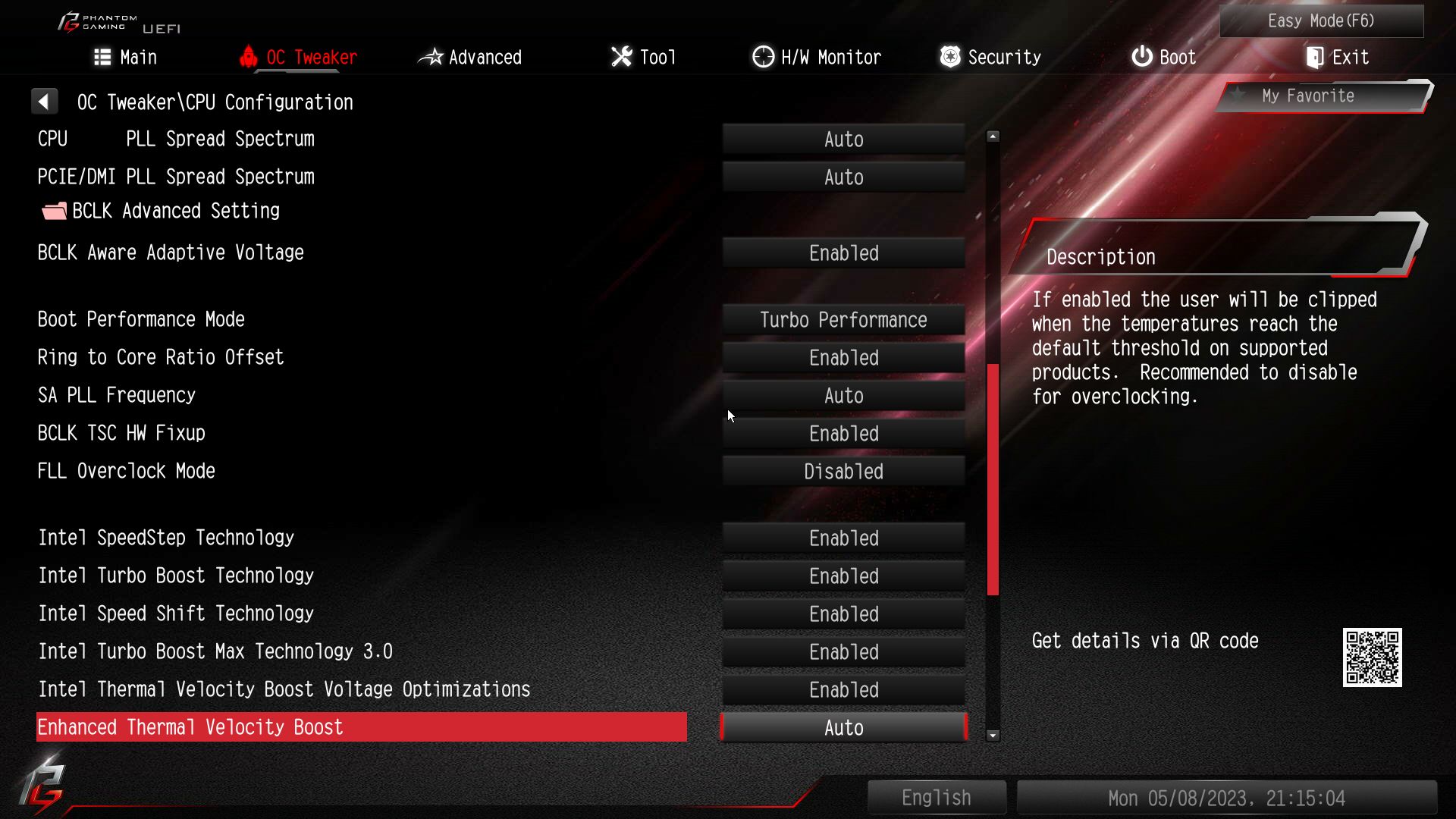


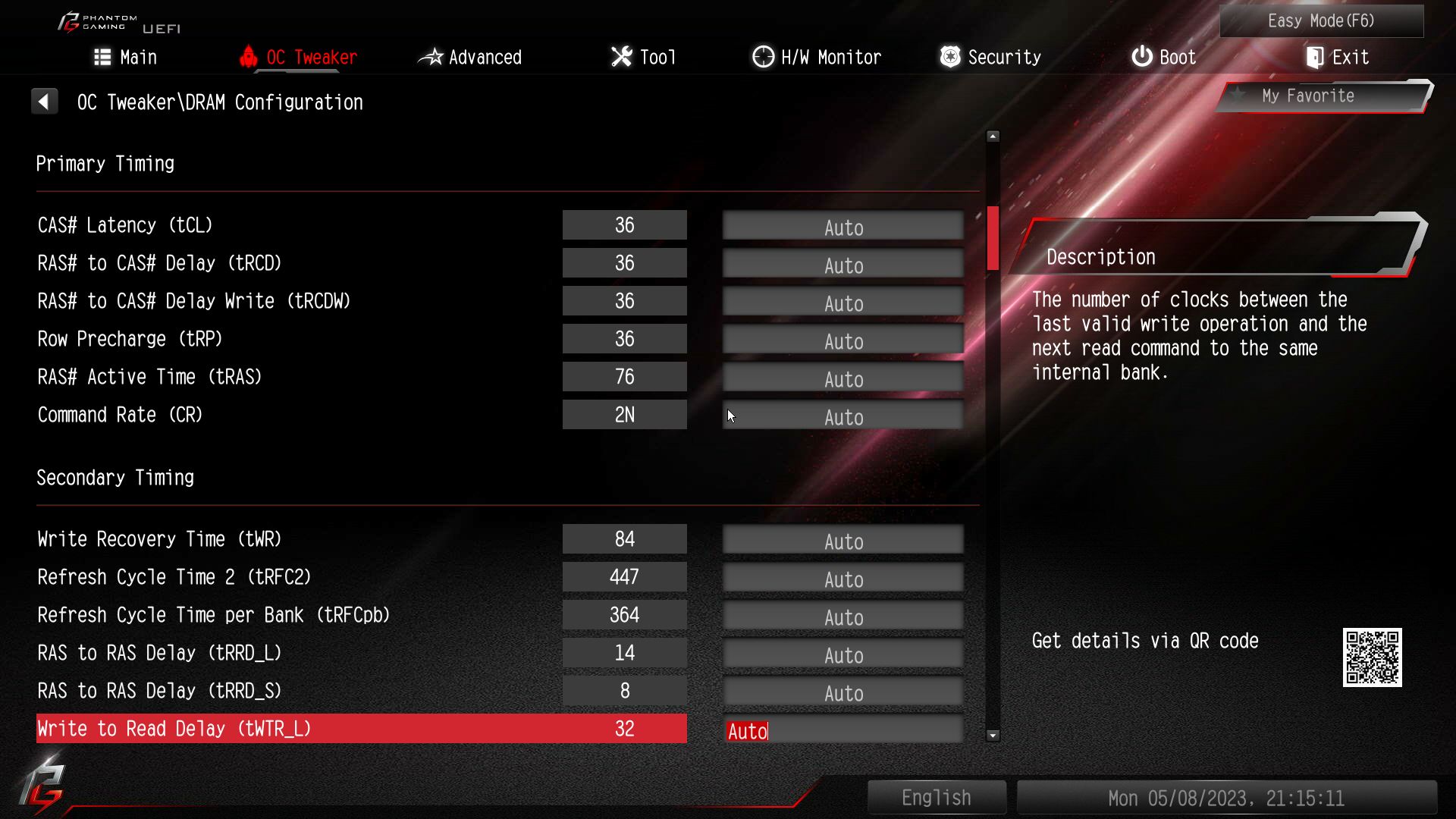
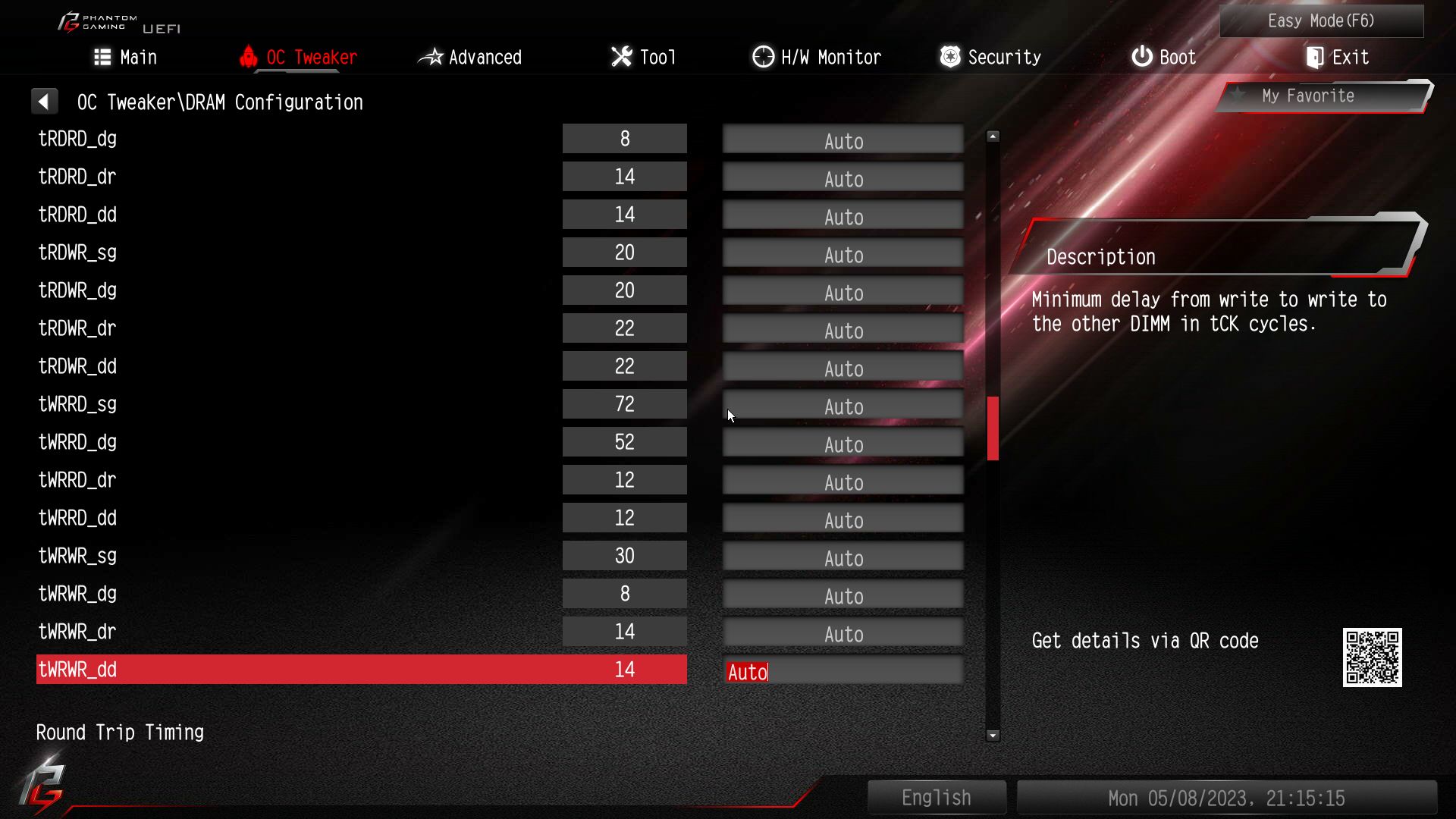

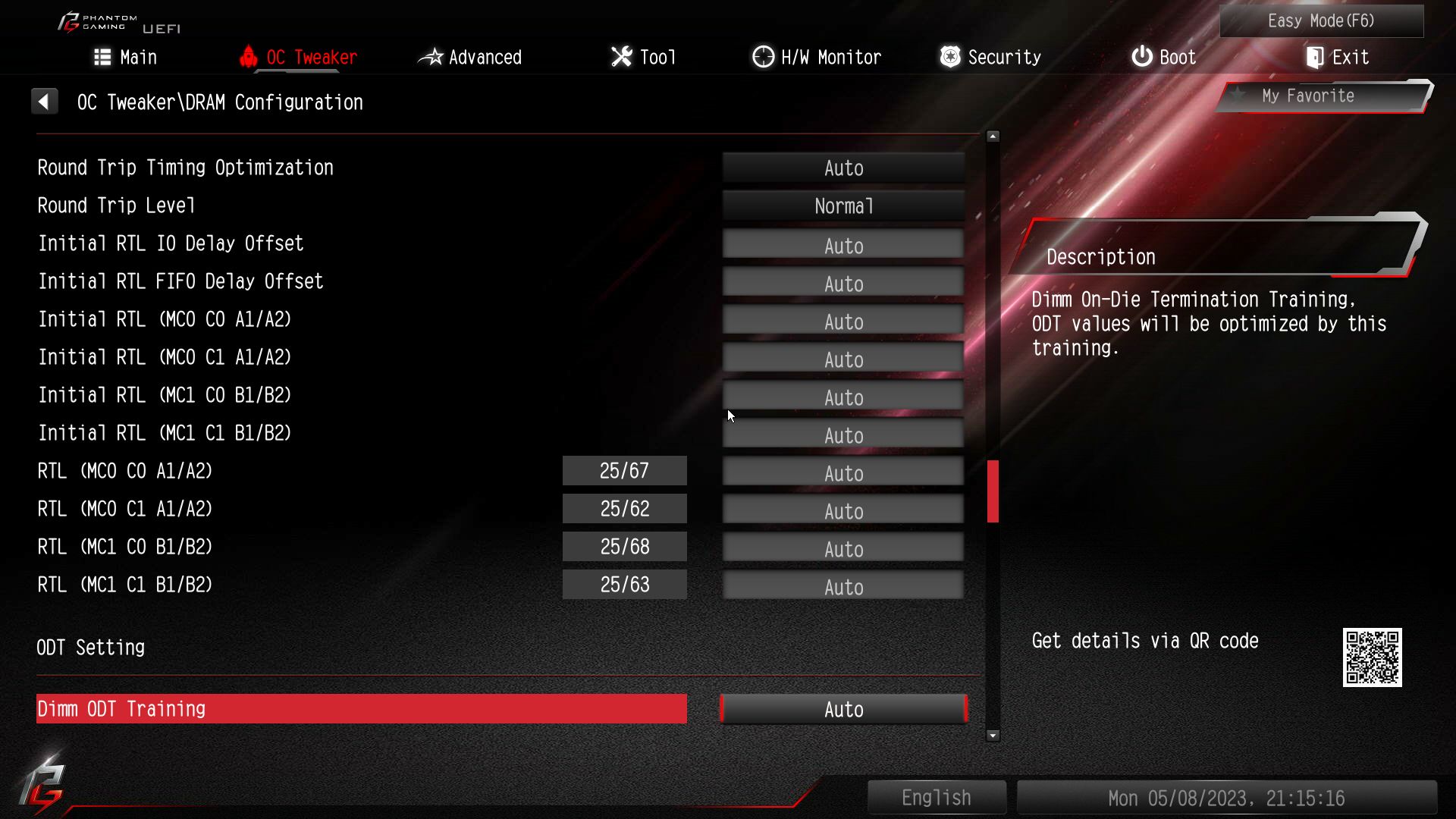
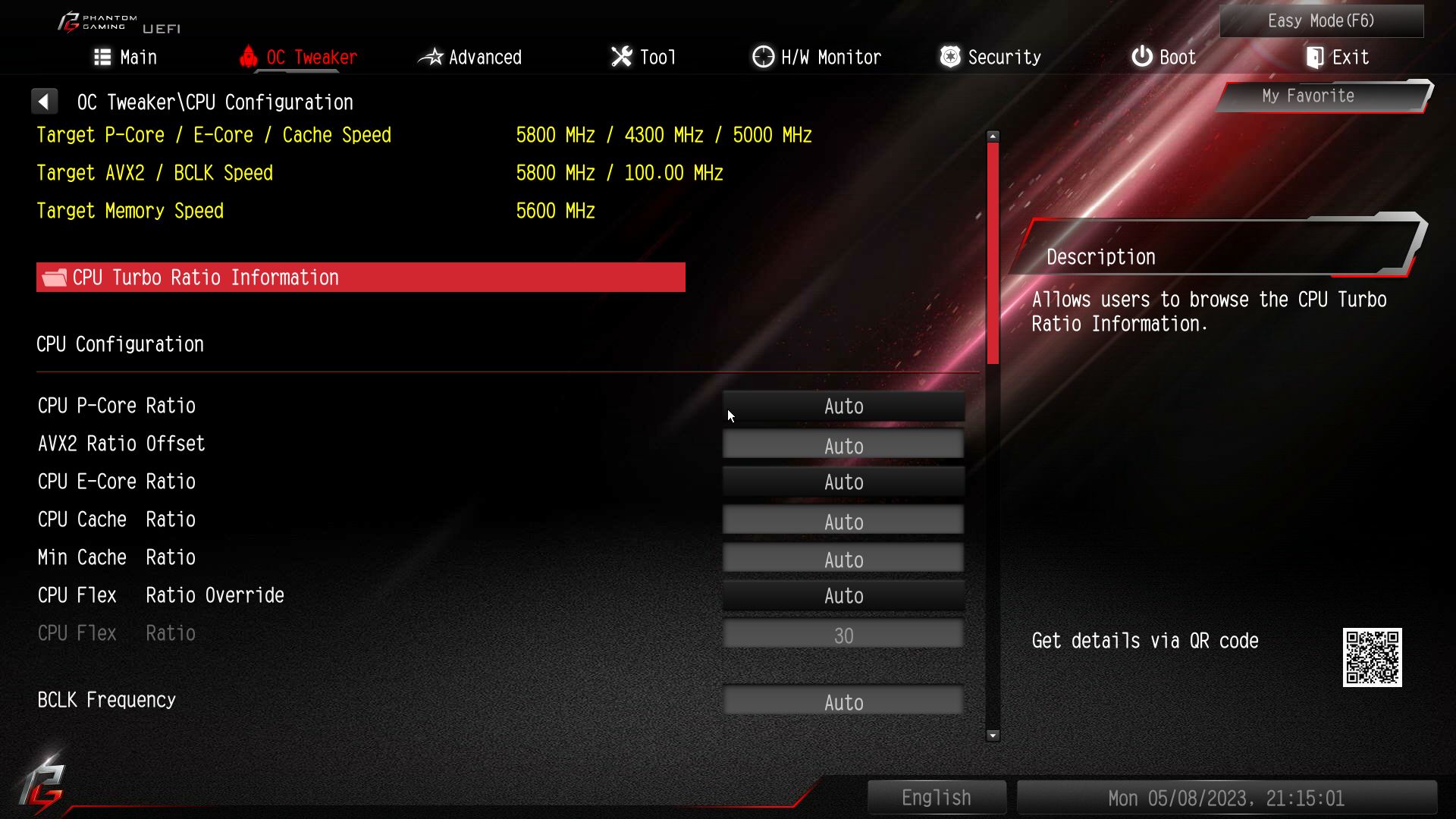

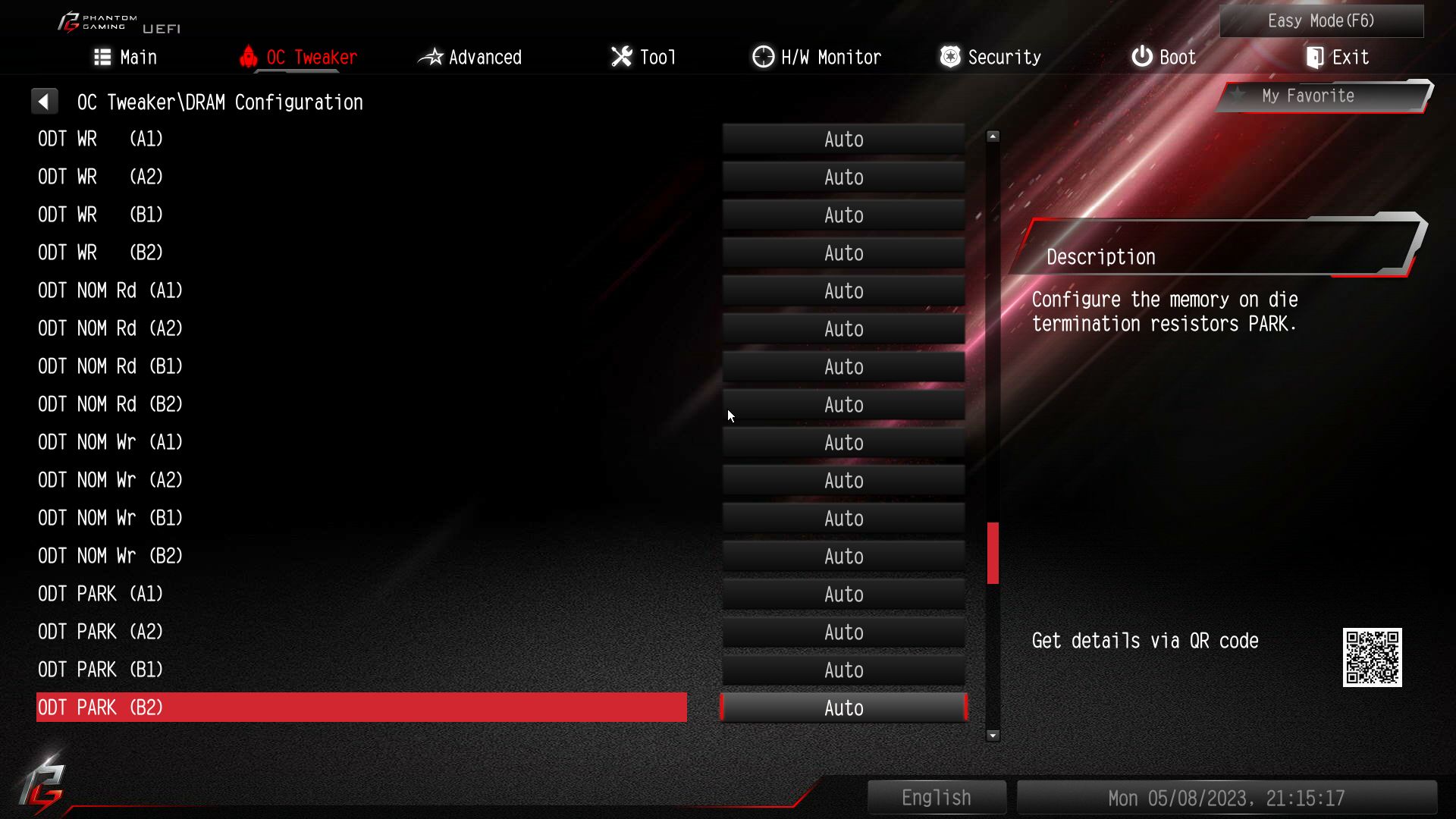
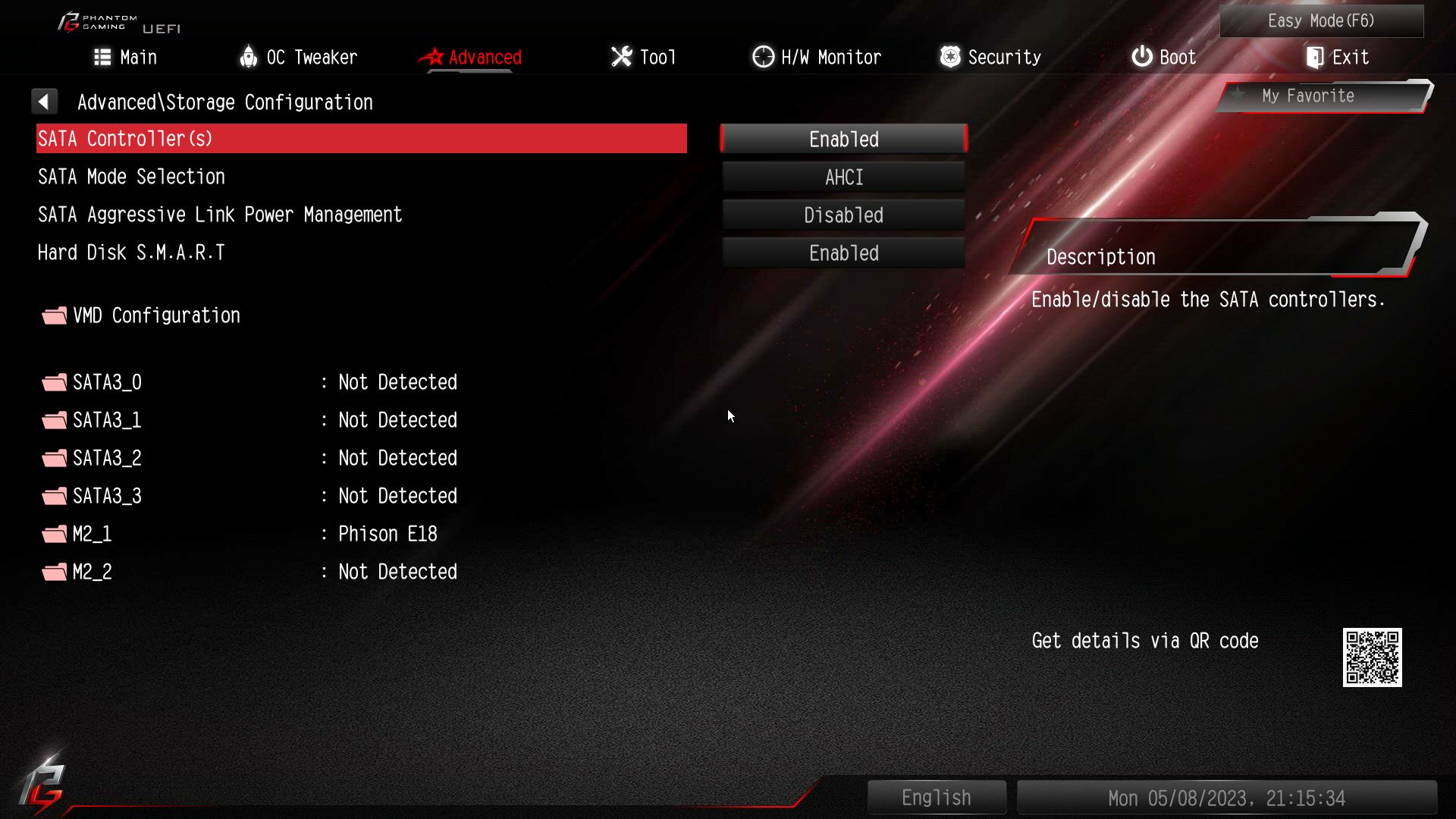
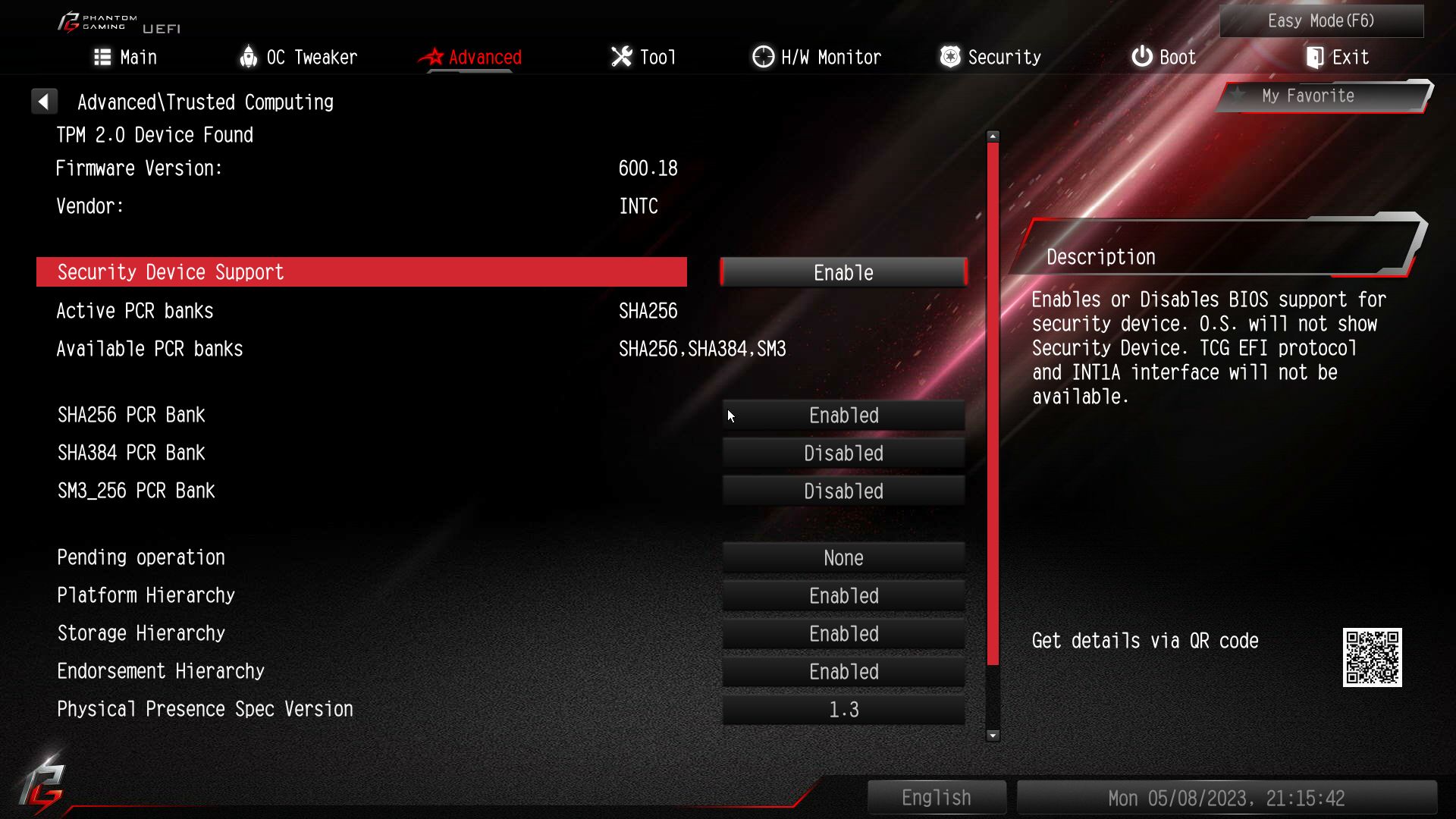



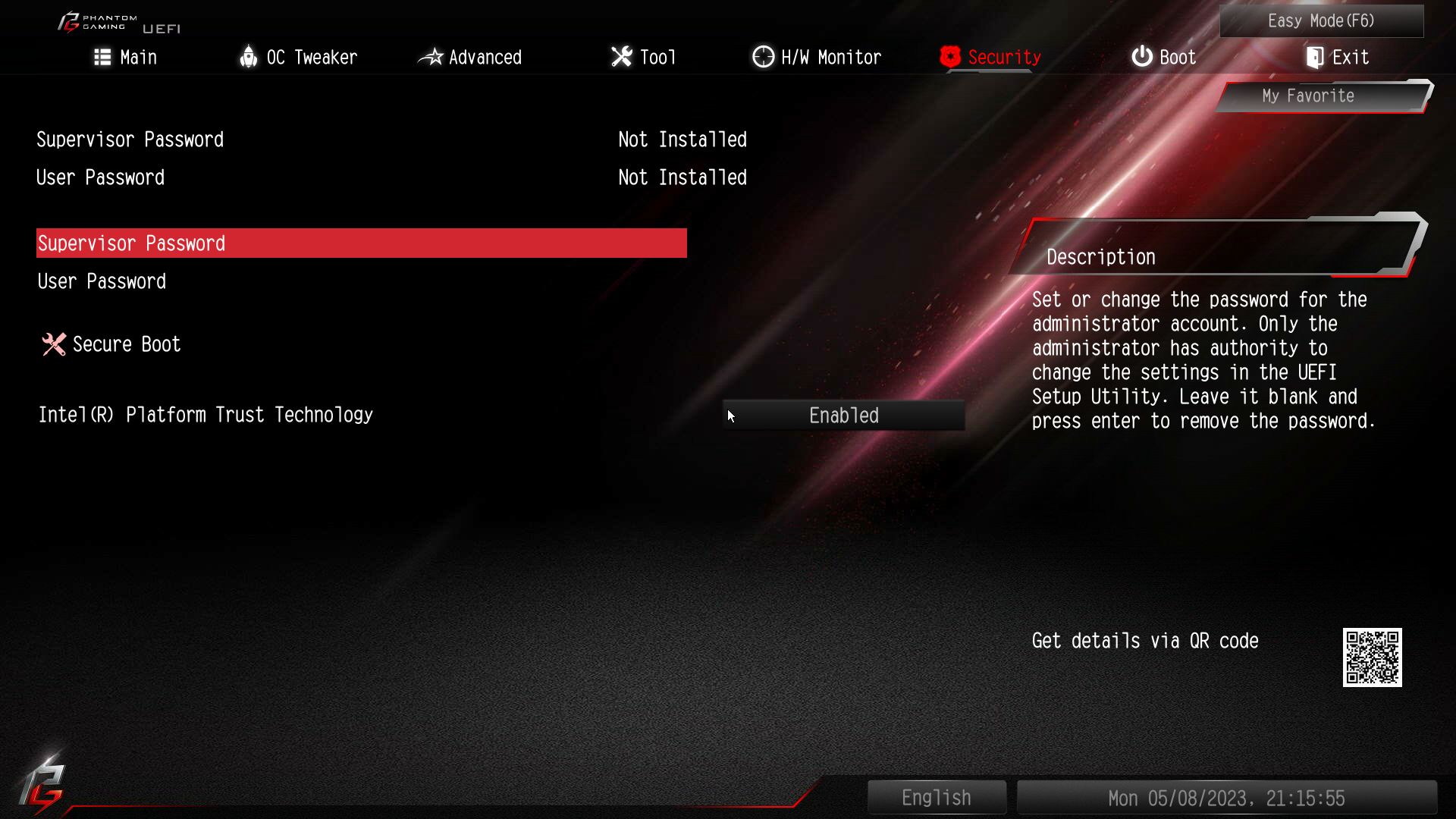
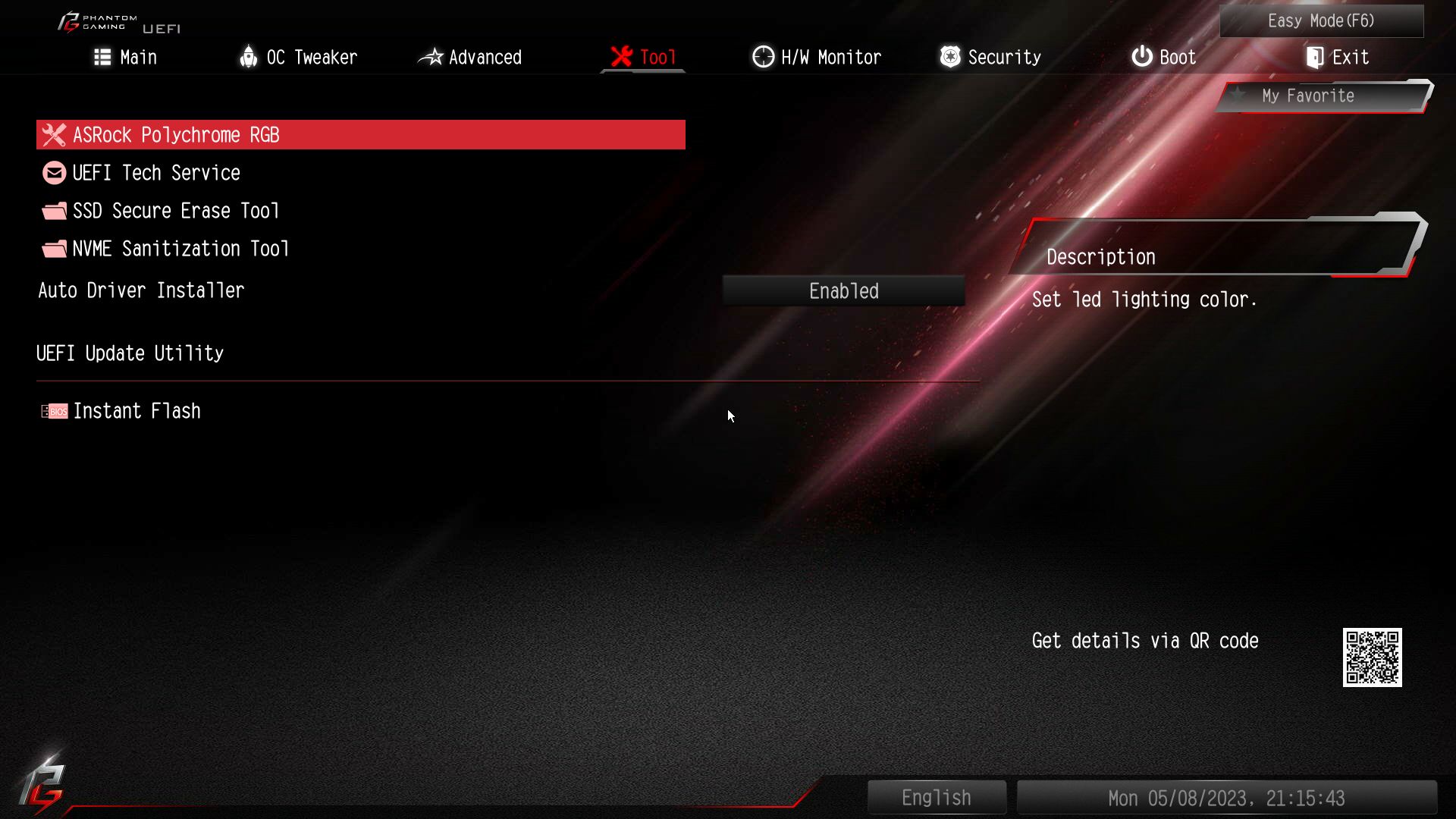


Software
For software, ASRock provides several different options. It has the App Shop to install drivers and software, the Nahimic 3 audio control panel, and the A-Tune application that overclocks your system (if applicable), controls fans, and more. There’s even a pop-up to install drivers when you first boot the system. ASRock’s software provides everything users need to manage and tweak their system.
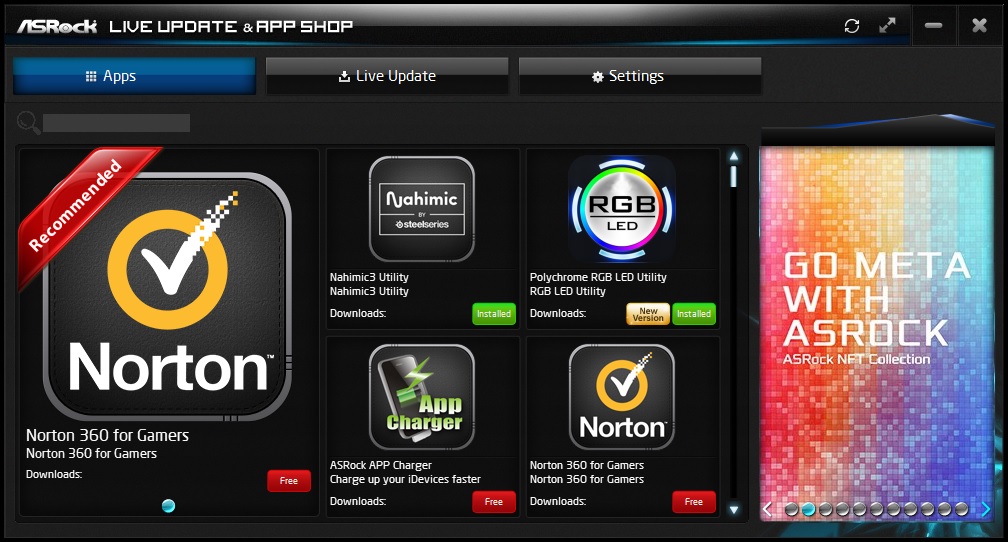
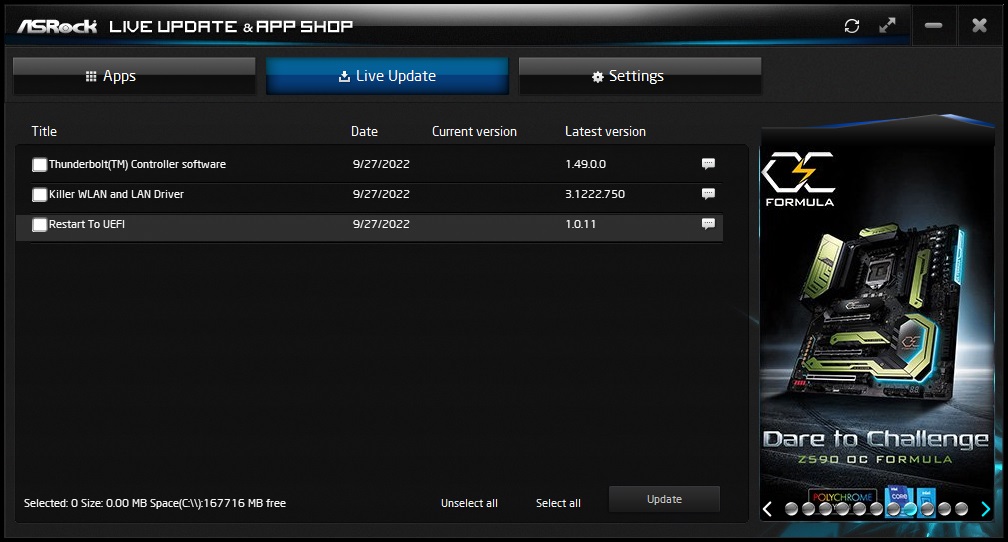
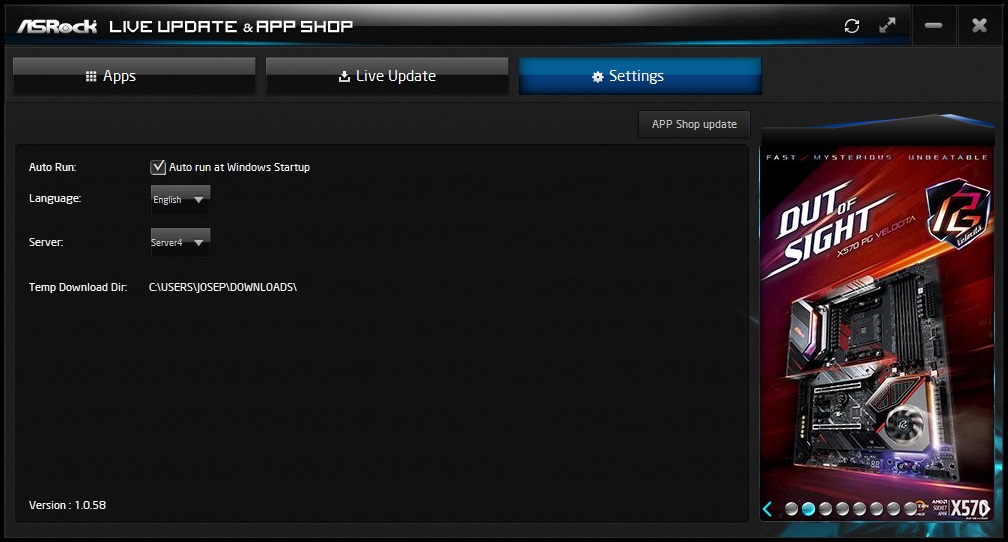
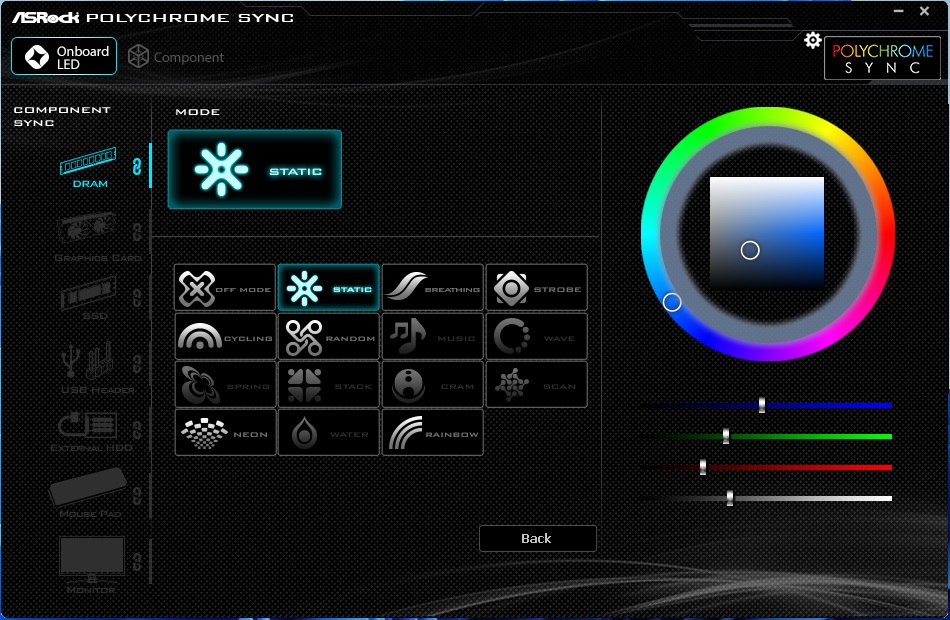

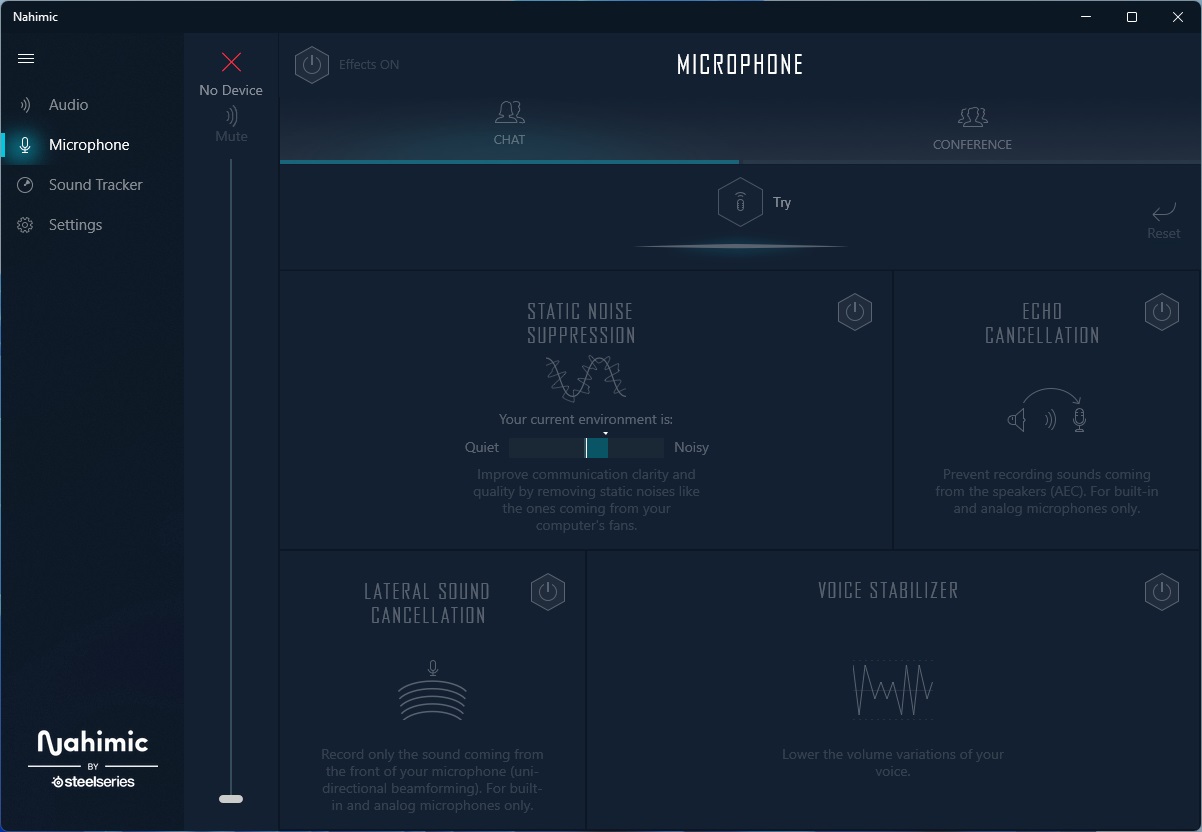

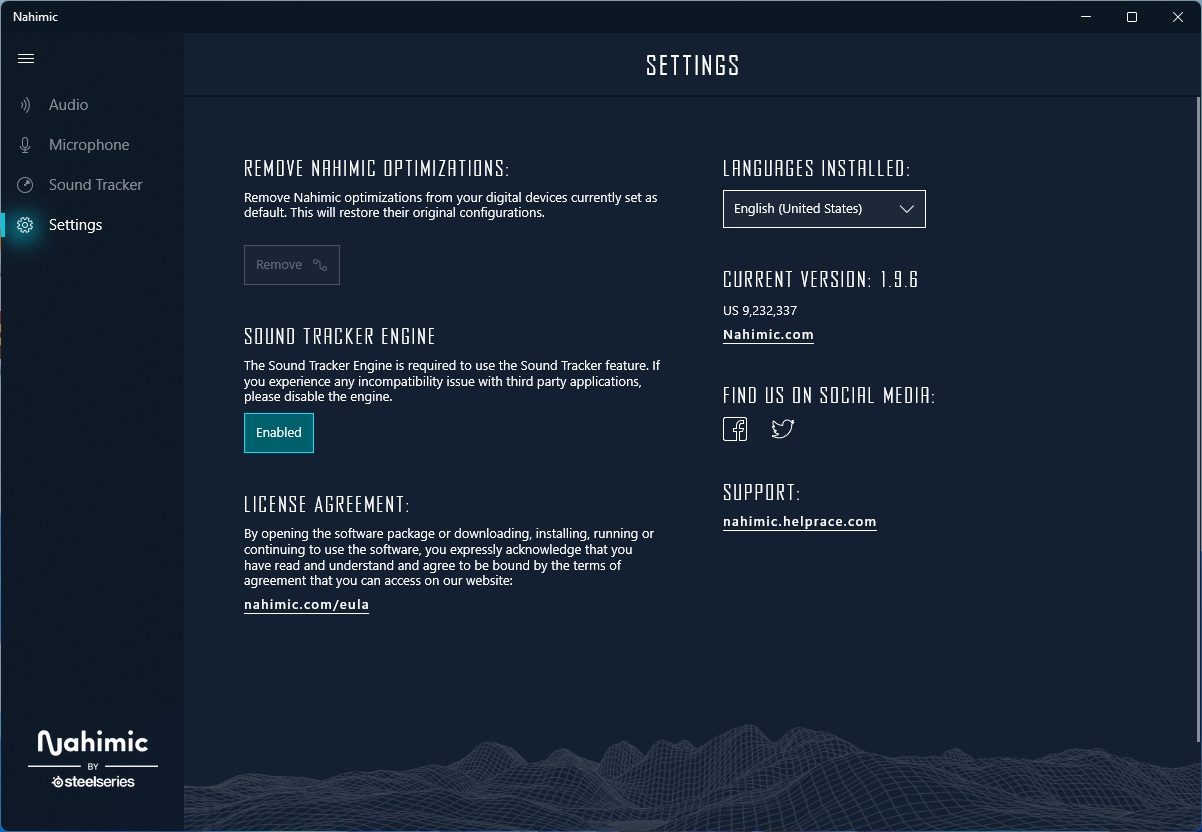
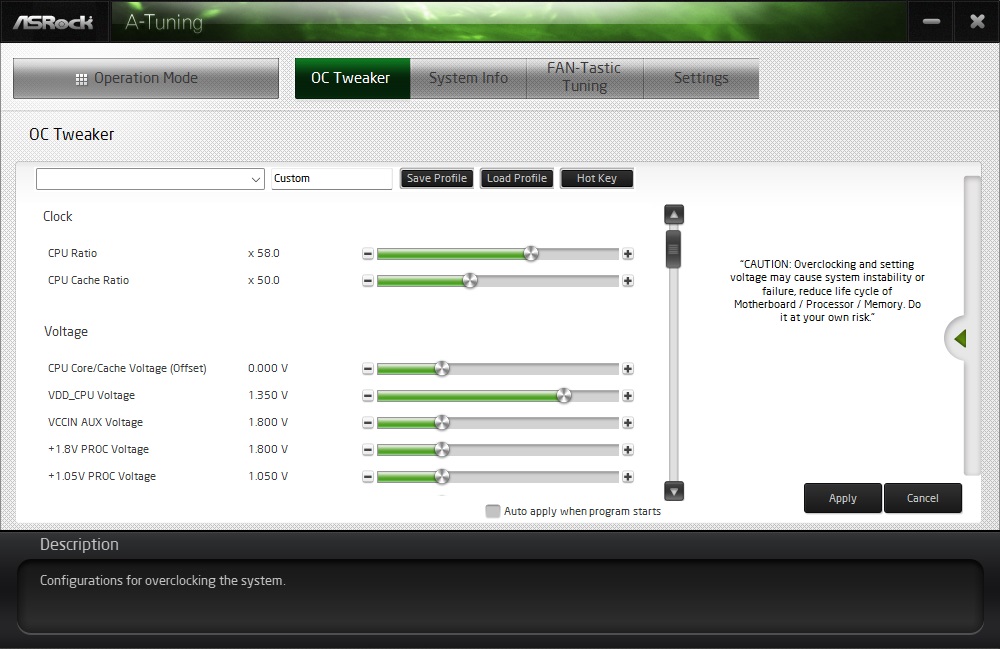
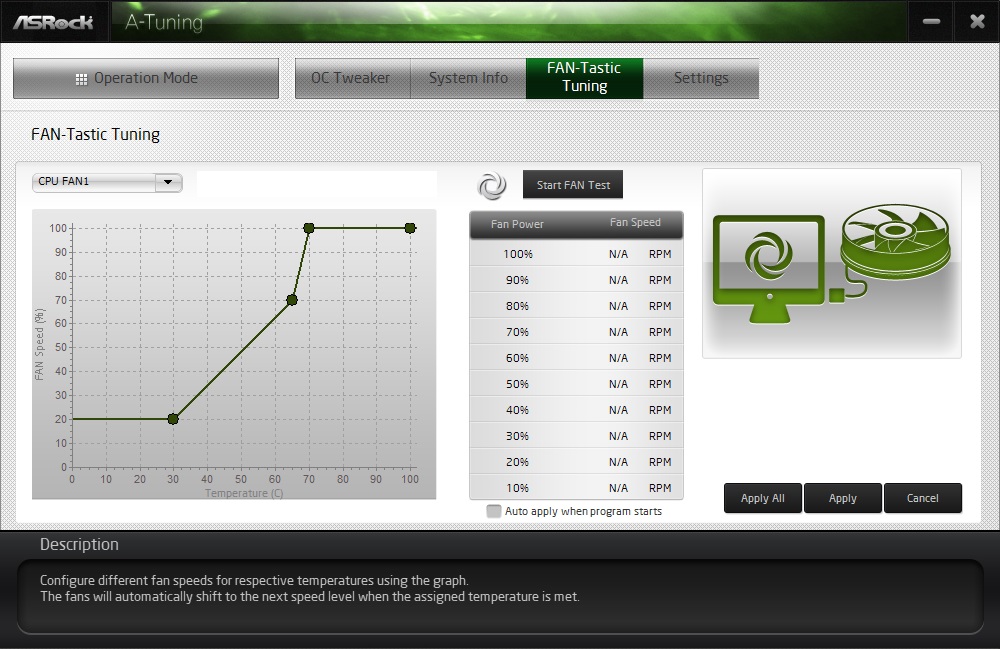


Test System / Comparison Products
We’ve updated our test system to 64-bit Windows 11, with all updates applied. We kept the same Asus TUF RTX 3070 video card from our previous testing platforms but updated the driver. Additionally, we updated to F1 22 in our games suite and kept Far Cry 6. We use the latest non-beta motherboard BIOS available to the public unless otherwise noted. The hardware we used is as follows:
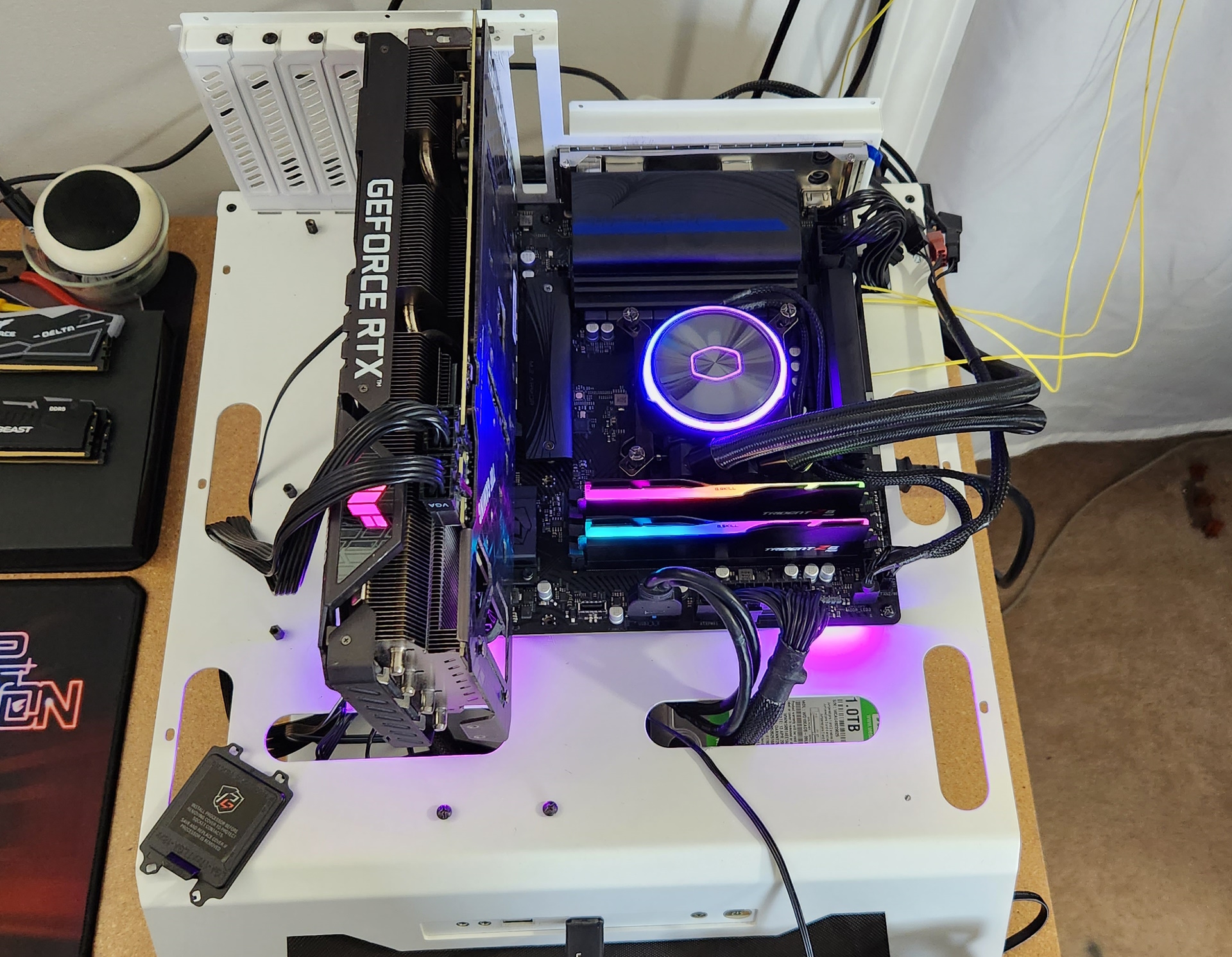
EVGA supplied our Supernova 850W P6 power supply (appropriately sized and more efficient than the 1.2KW monster we used previously) for our test systems, and G.Skill sent us a DDR5-5600 (F5-5600U3636C16GX2-TZ5RK) memory kit for testing.

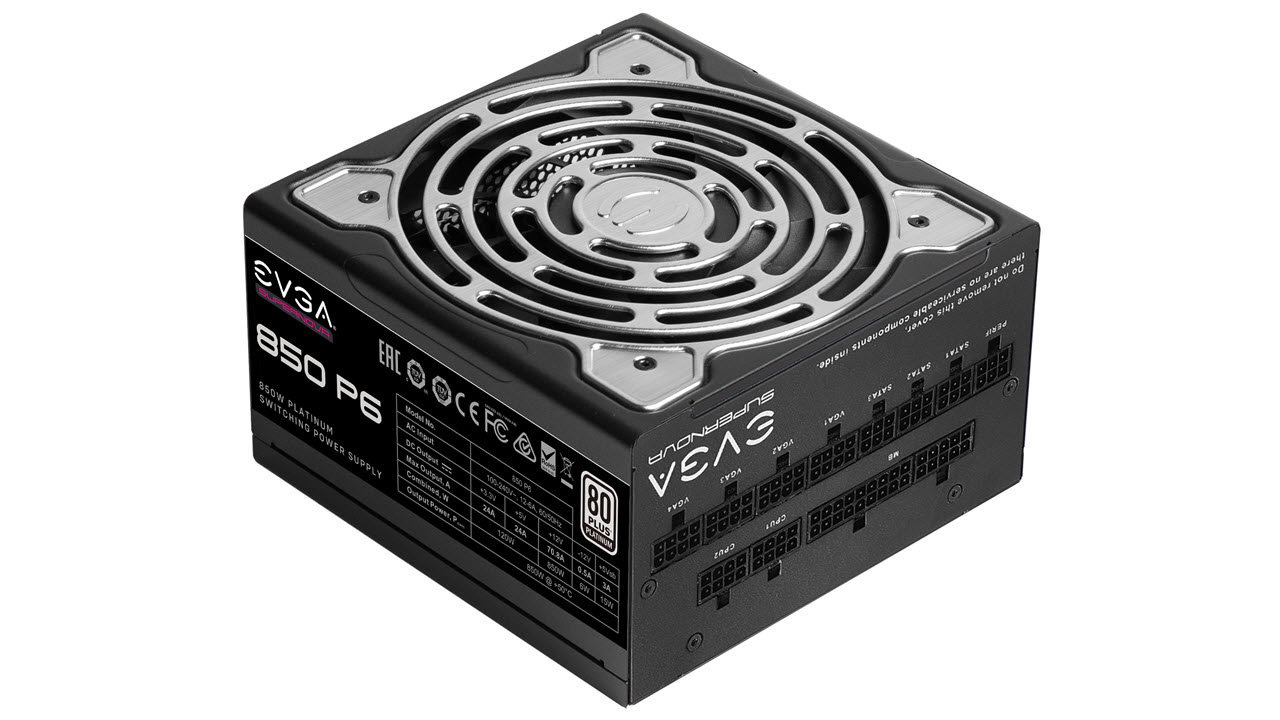
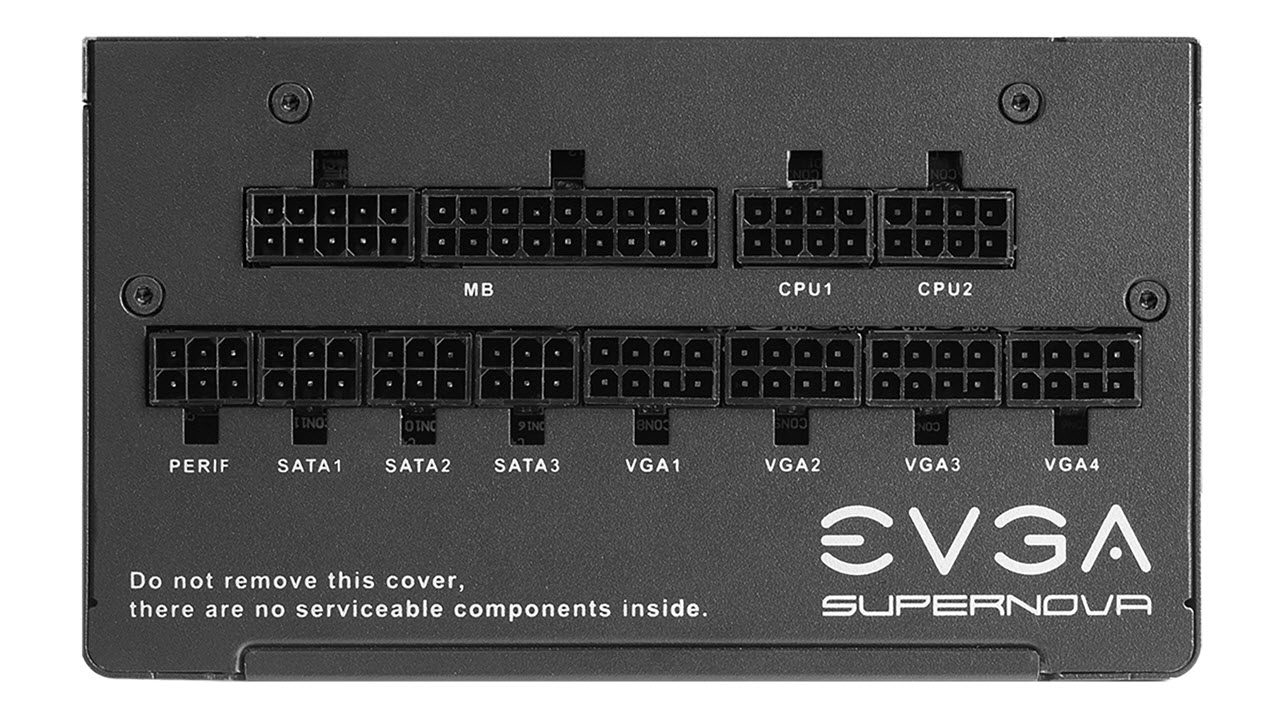
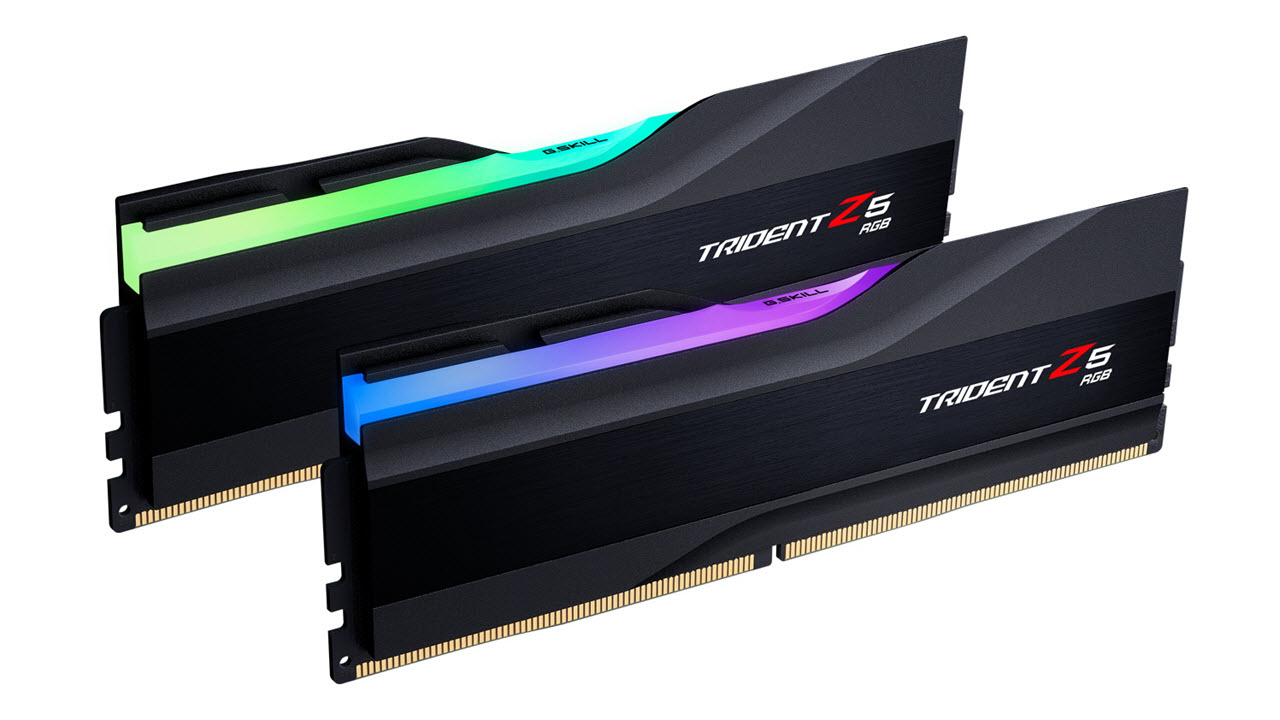
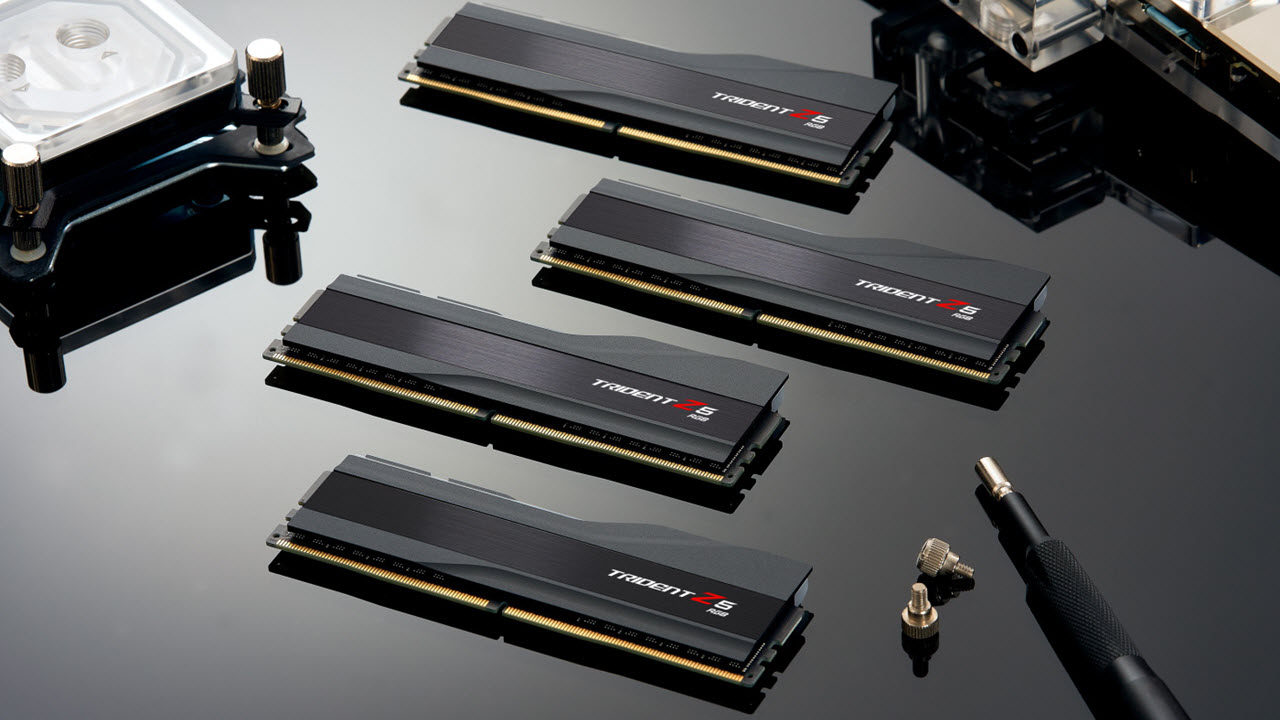
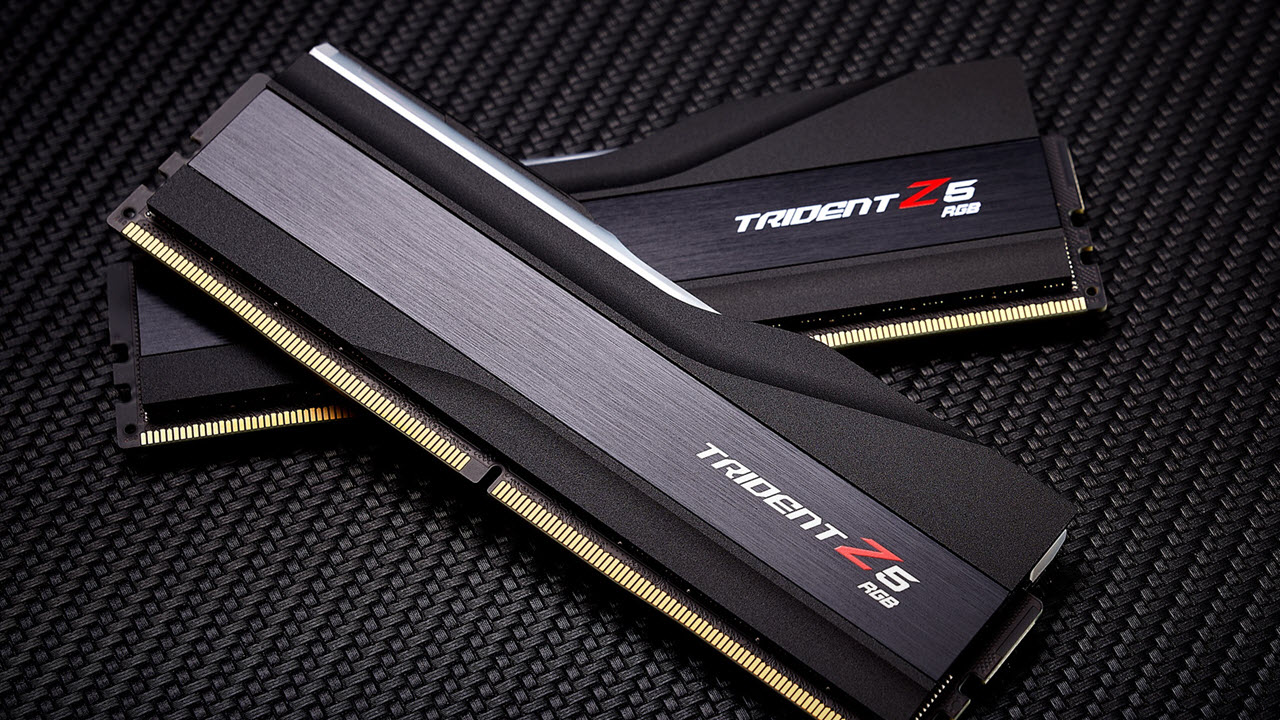
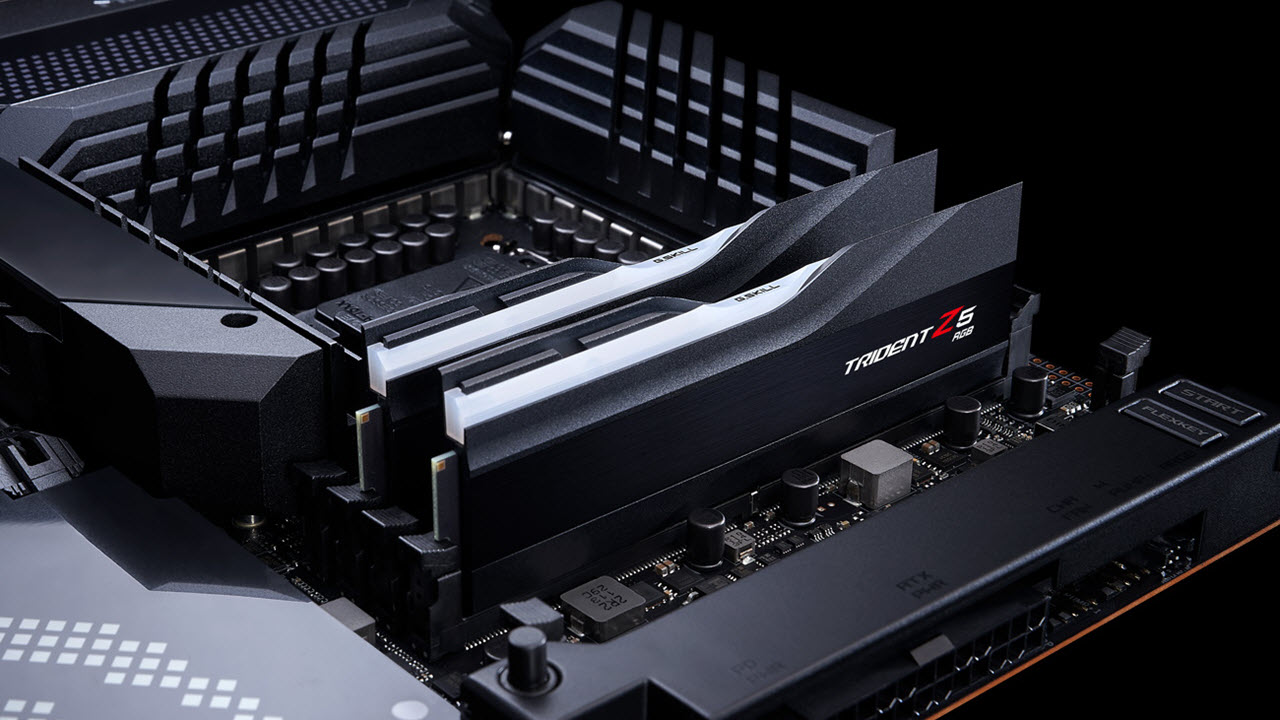
Benchmark Settings
MORE: Best Motherboards
MORE: How To Choose A Motherboard
MORE: All Motherboard Content
Benchmark Results
Our standard benchmarks and power tests are performed using the CPU’s stock frequencies (including any default boost/turbo), with all power-saving features enabled. We set optimized defaults in the BIOS and the memory by enabling the XMP profile. The Windows power scheme is set to Balanced (default) for this baseline testing, so the PC idles appropriately.
Synthetic Benchmarks
Synthetics provide a great way to determine how a board runs, as identical settings should produce similar performance results. Turbo boost wattage and advanced memory timings are places where motherboard makers can still optimize for stability or performance, though, and those settings can impact some testing.
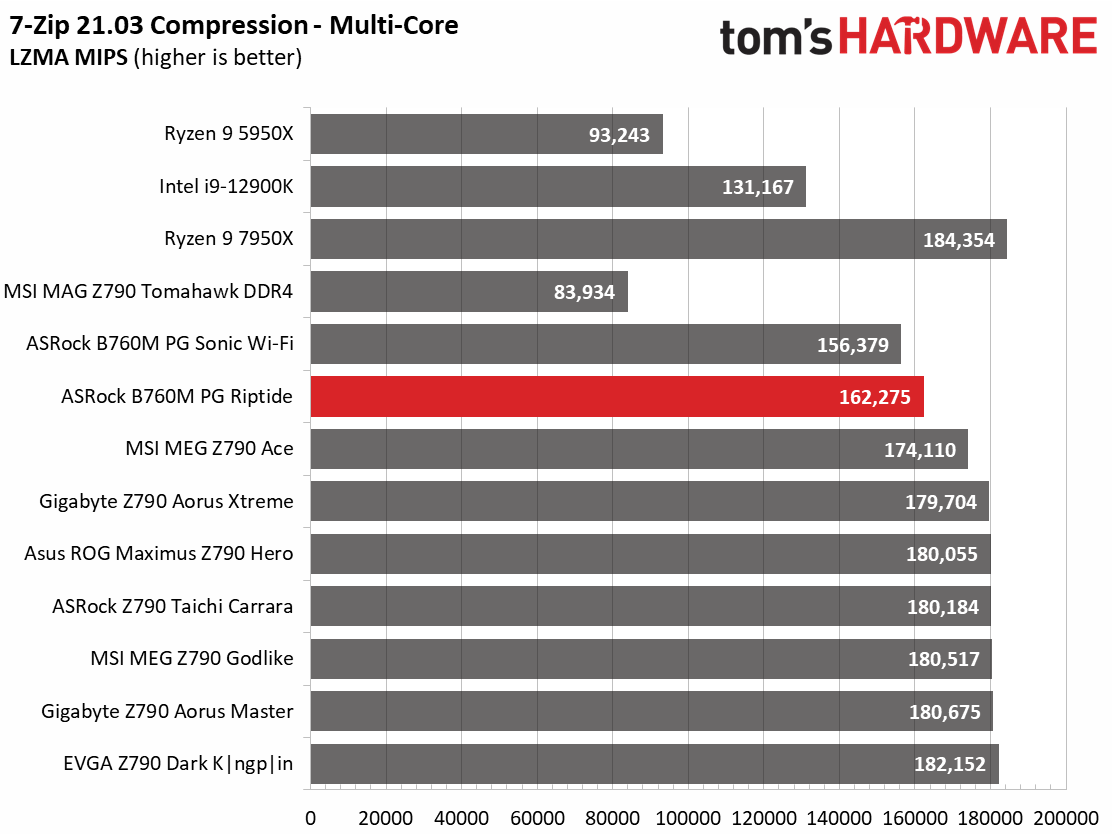


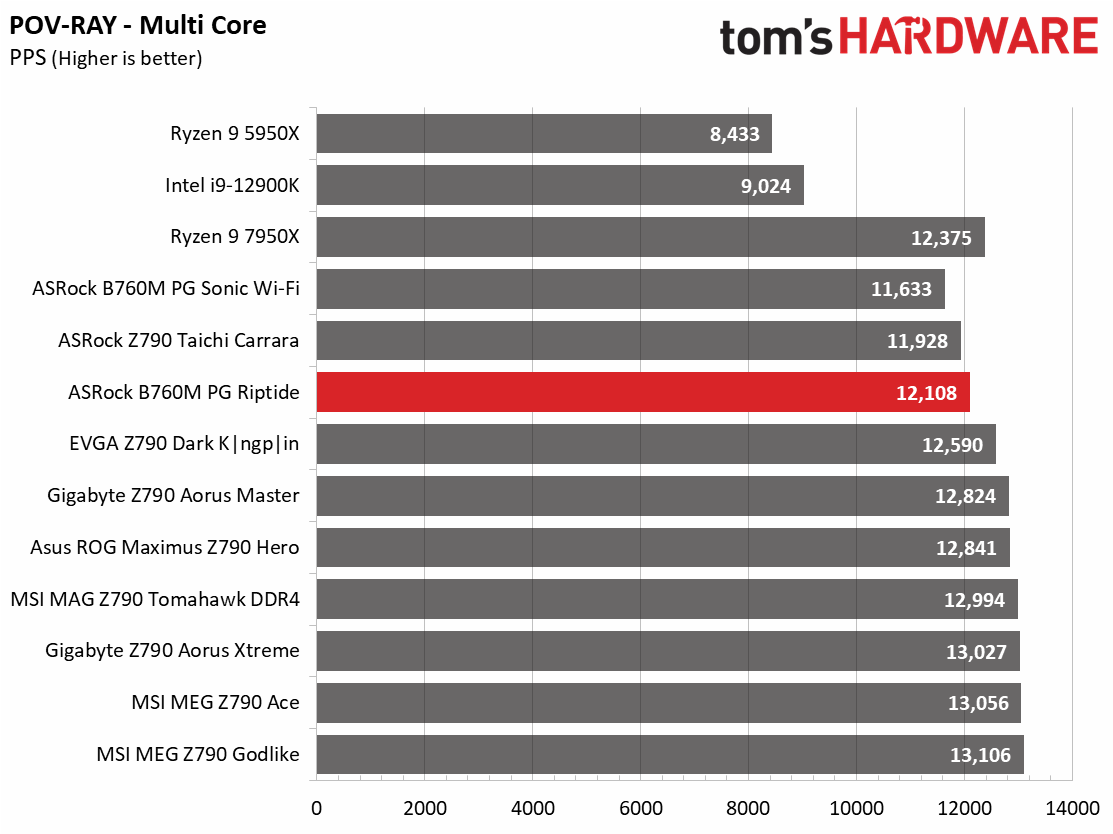
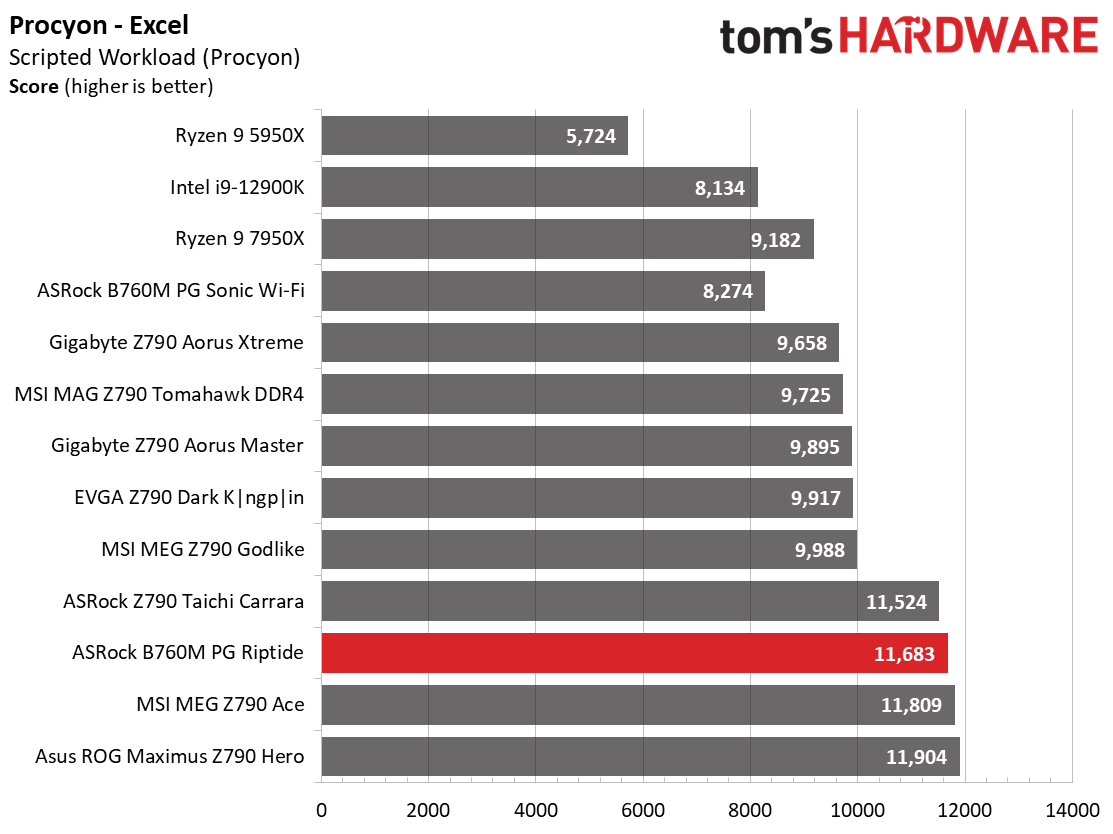
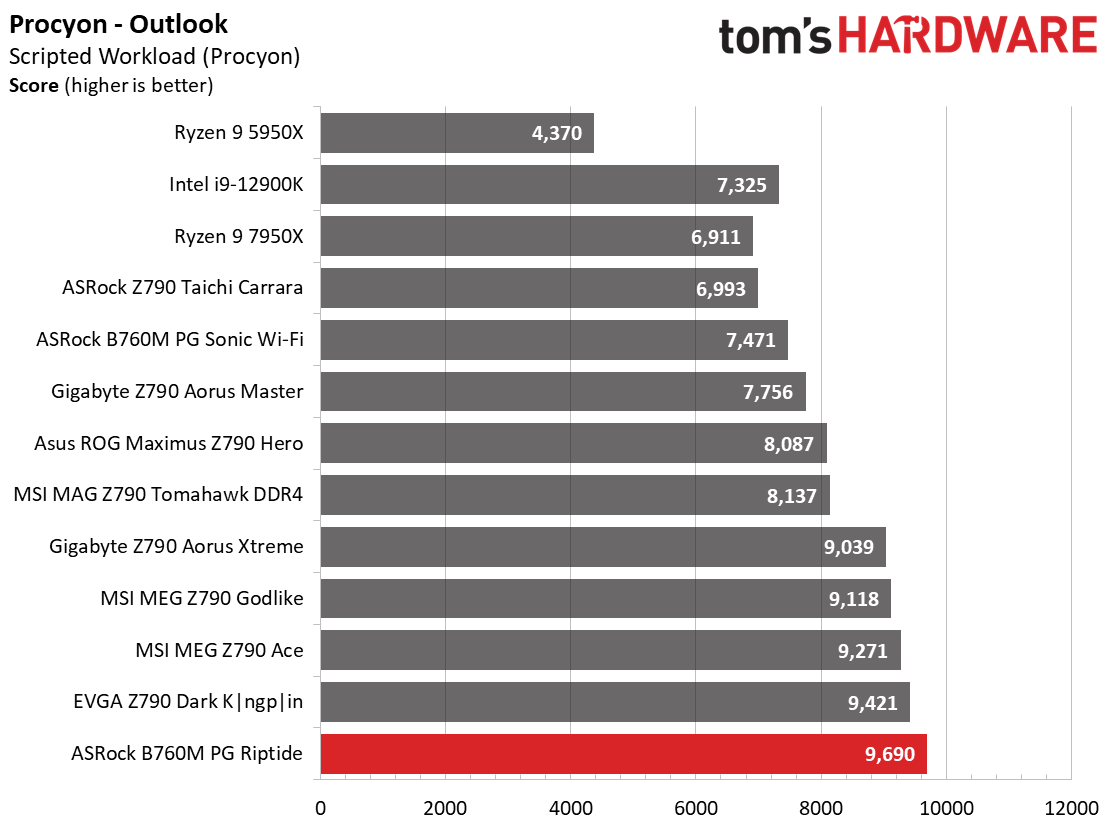
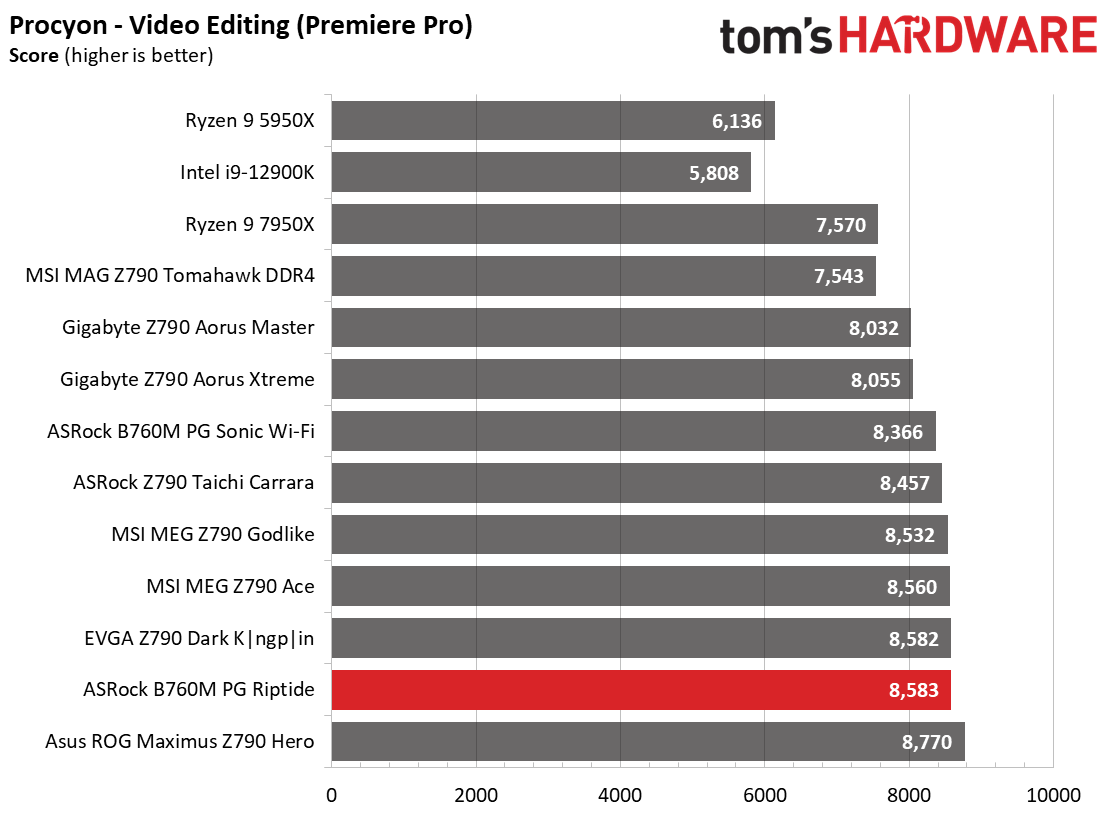

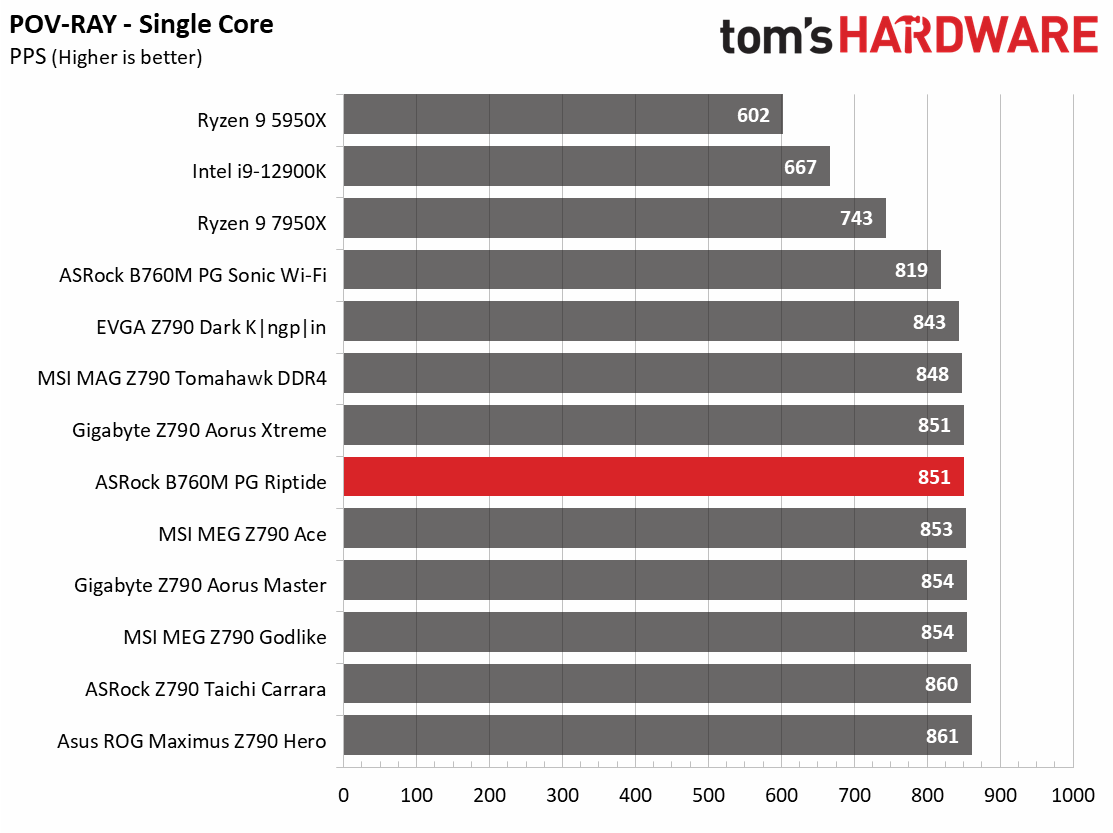
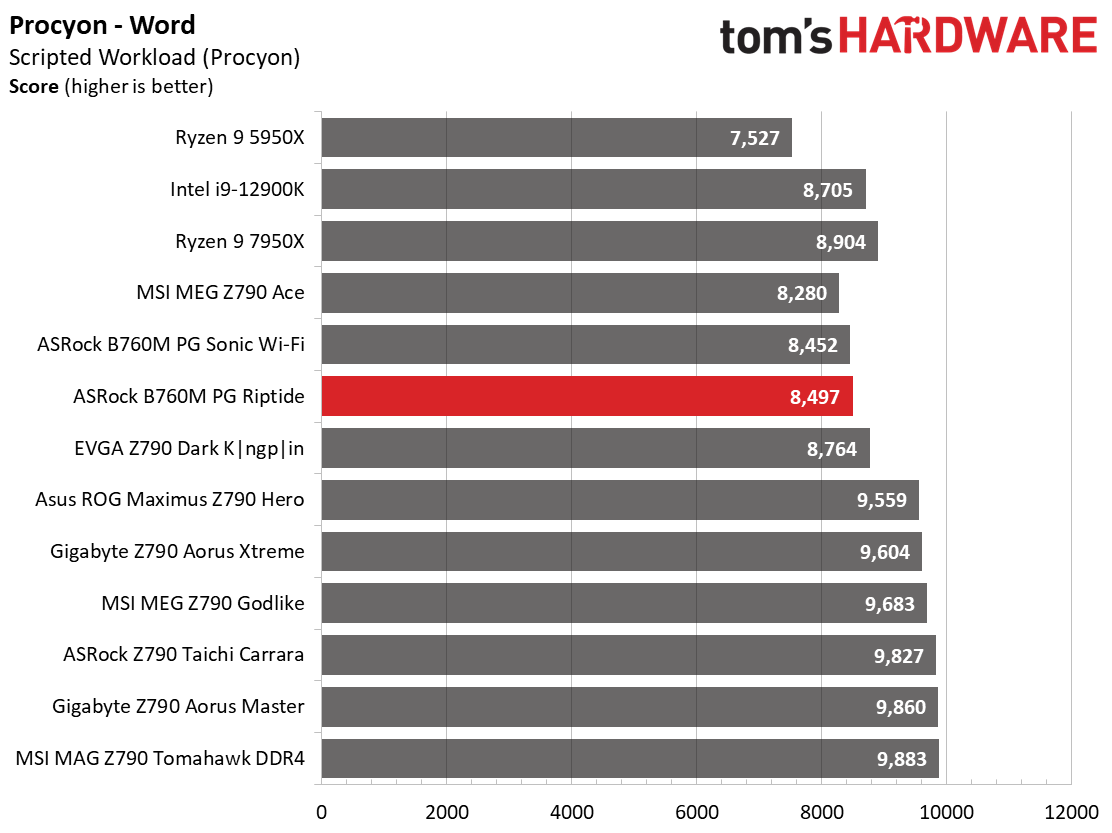
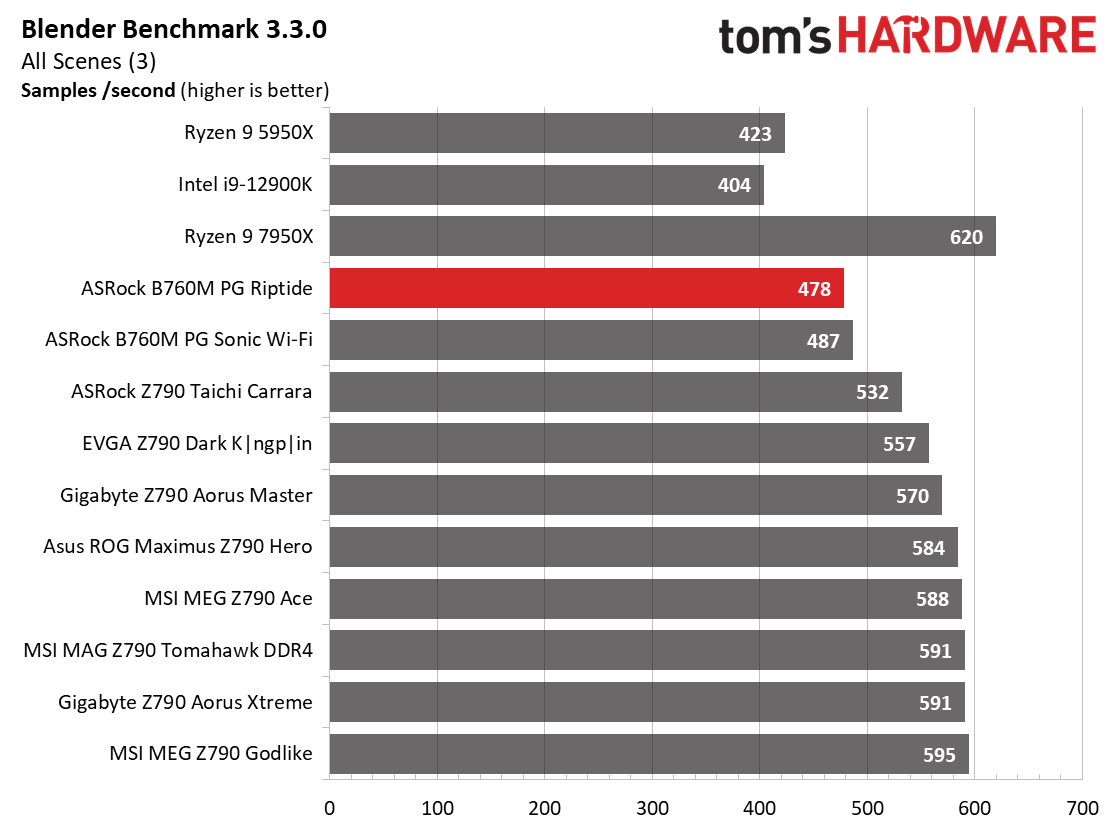

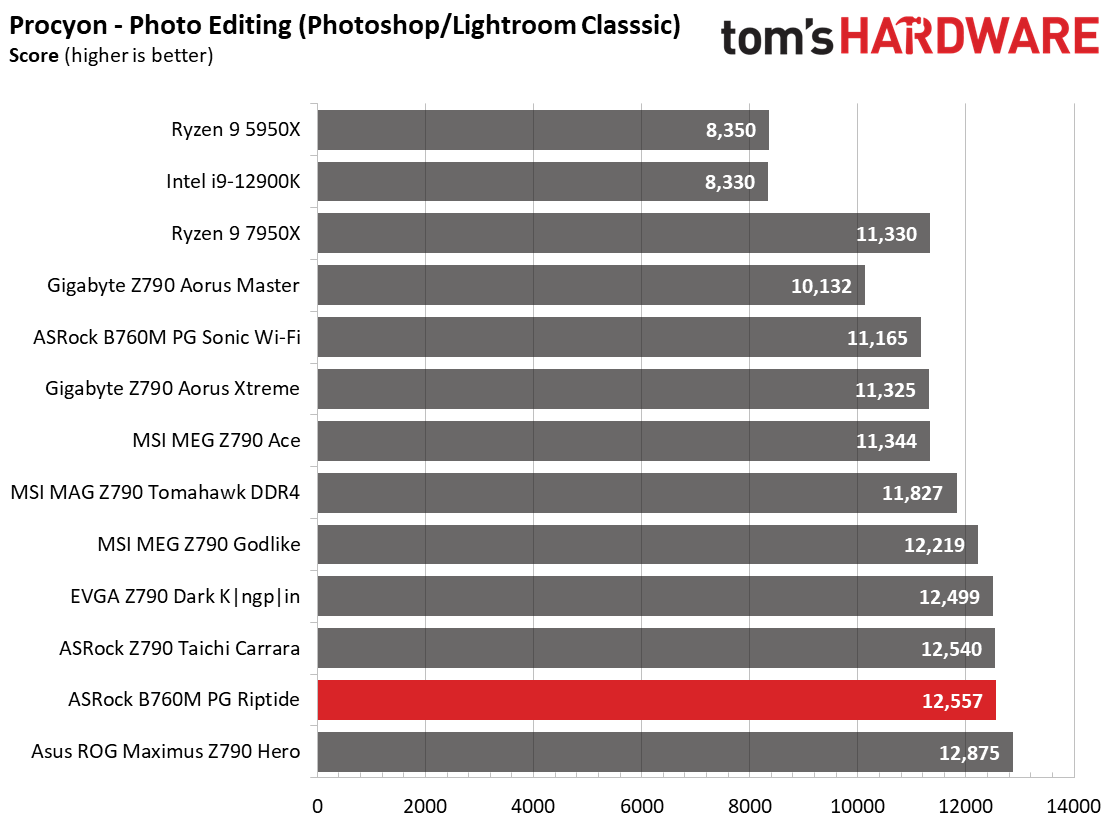
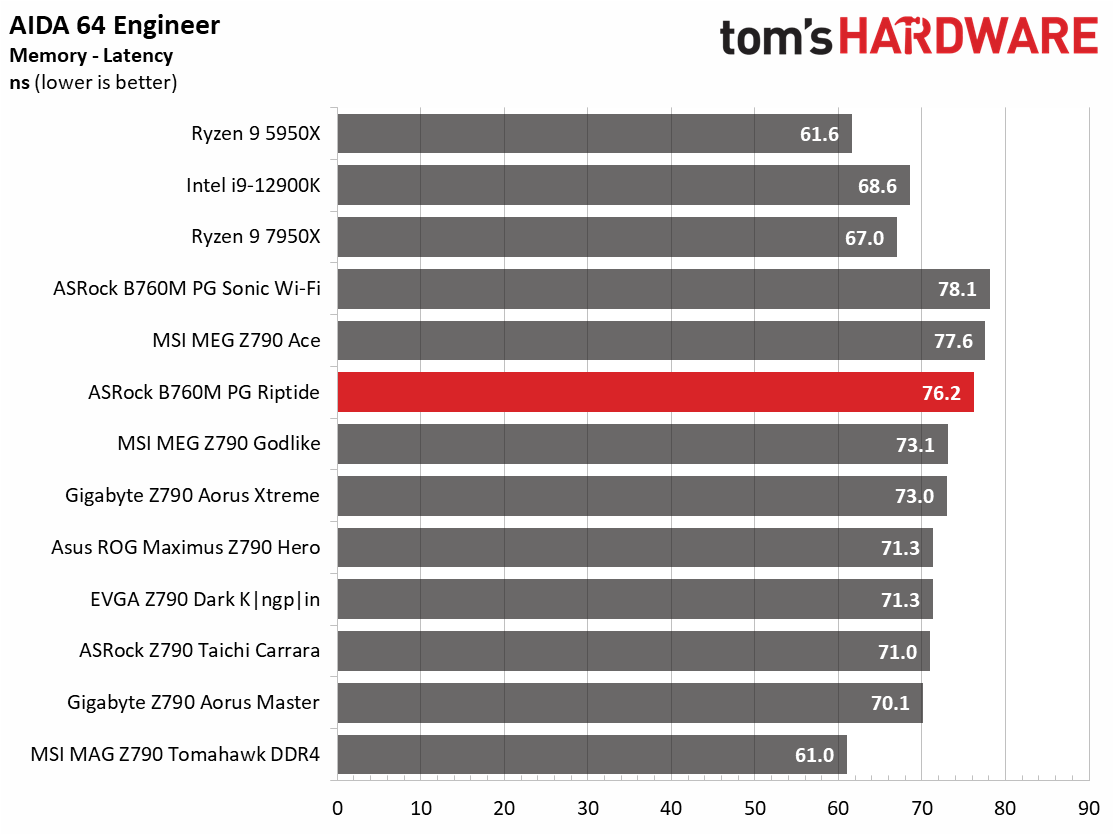


Looking at our synthetic benchmark results, the PG Riptide was all over the place with average to above-average results in the Procyon Suite (including Photo/Video editing) and gaming, to some of the slower we’ve seen in 7-Zip, Cinebench, POV-Ray and Blender. It performs this way as our board follows the Intel boost specs out of the box, whereas others tend to have more headroom. You can get more performance by increasing the PL1 value (and overclocking via BCLK).
Time Applications
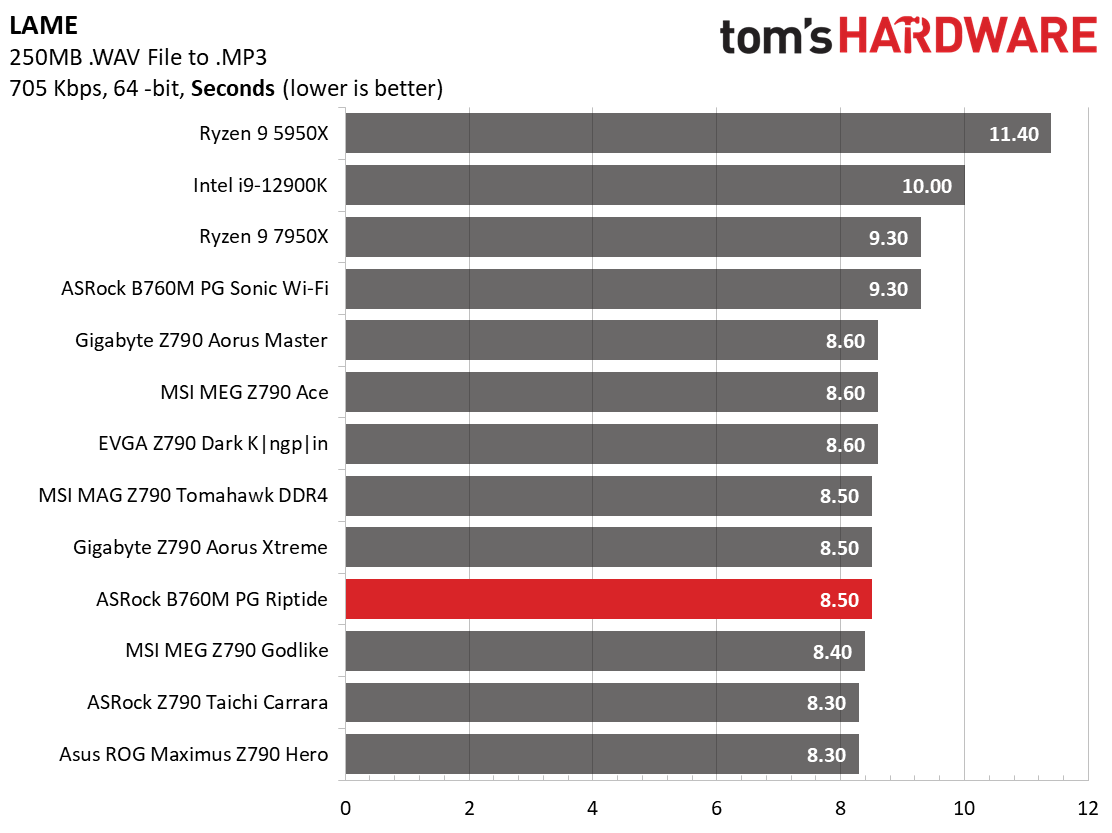
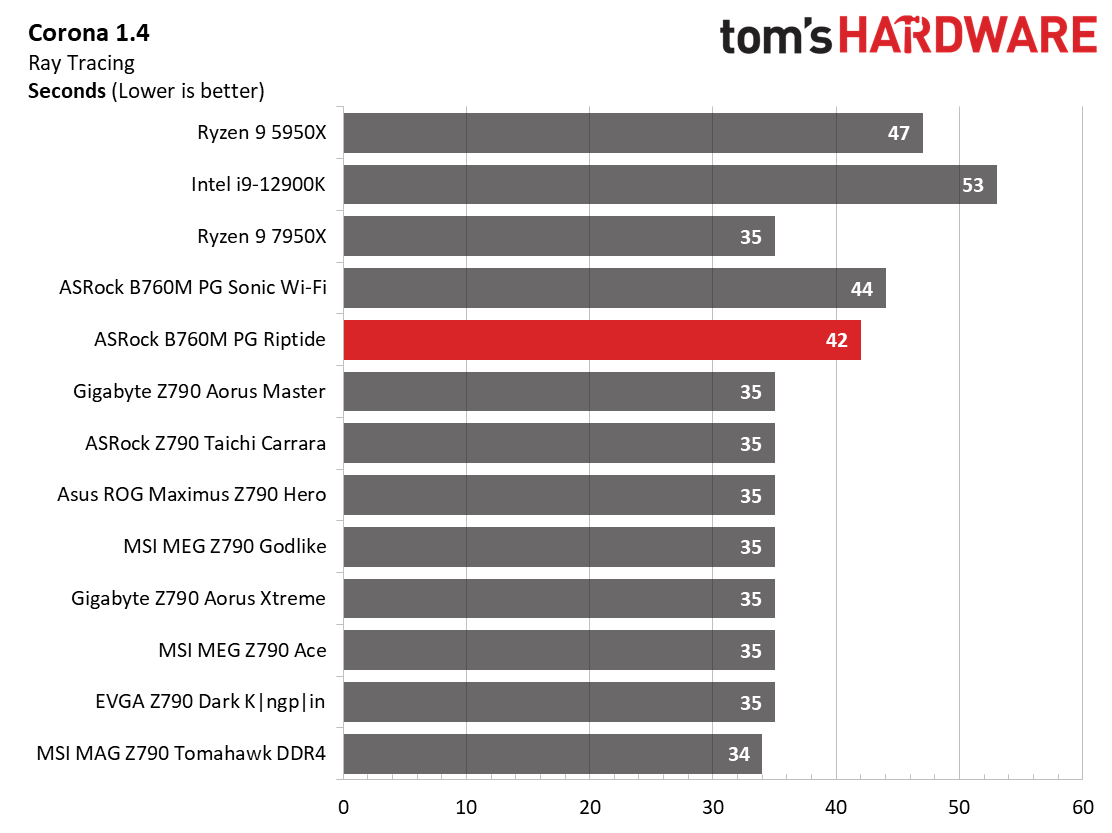

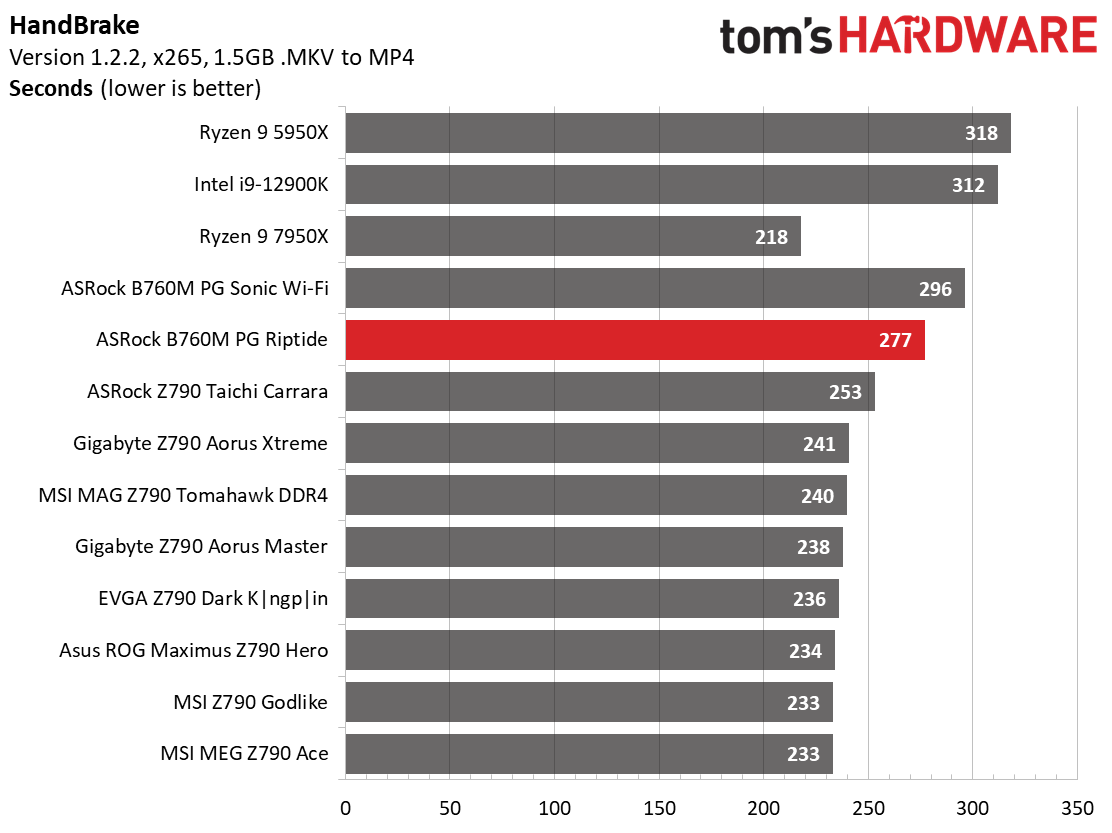
All of our timed applications are some of the slowest we’ve recorded (again due to following Intel boost specs). Only the PG Sonic we looked at recently was slower in these tests.
3D Games and 3DMark
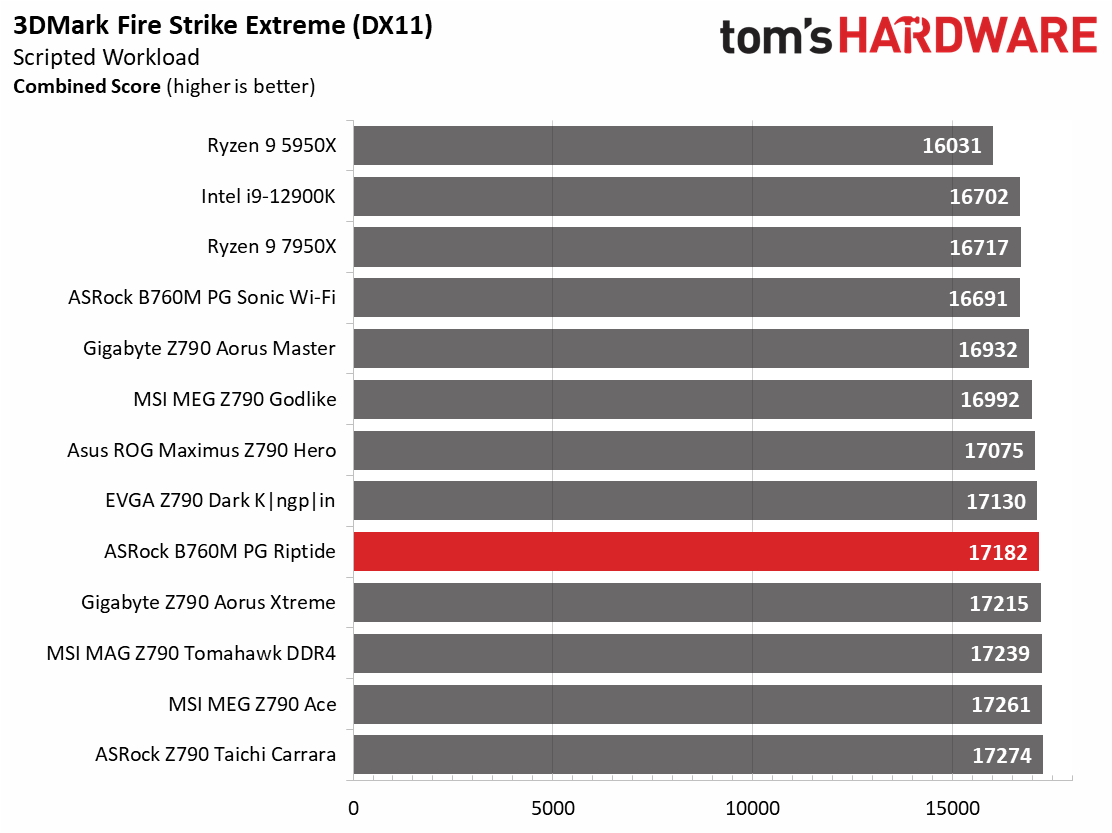
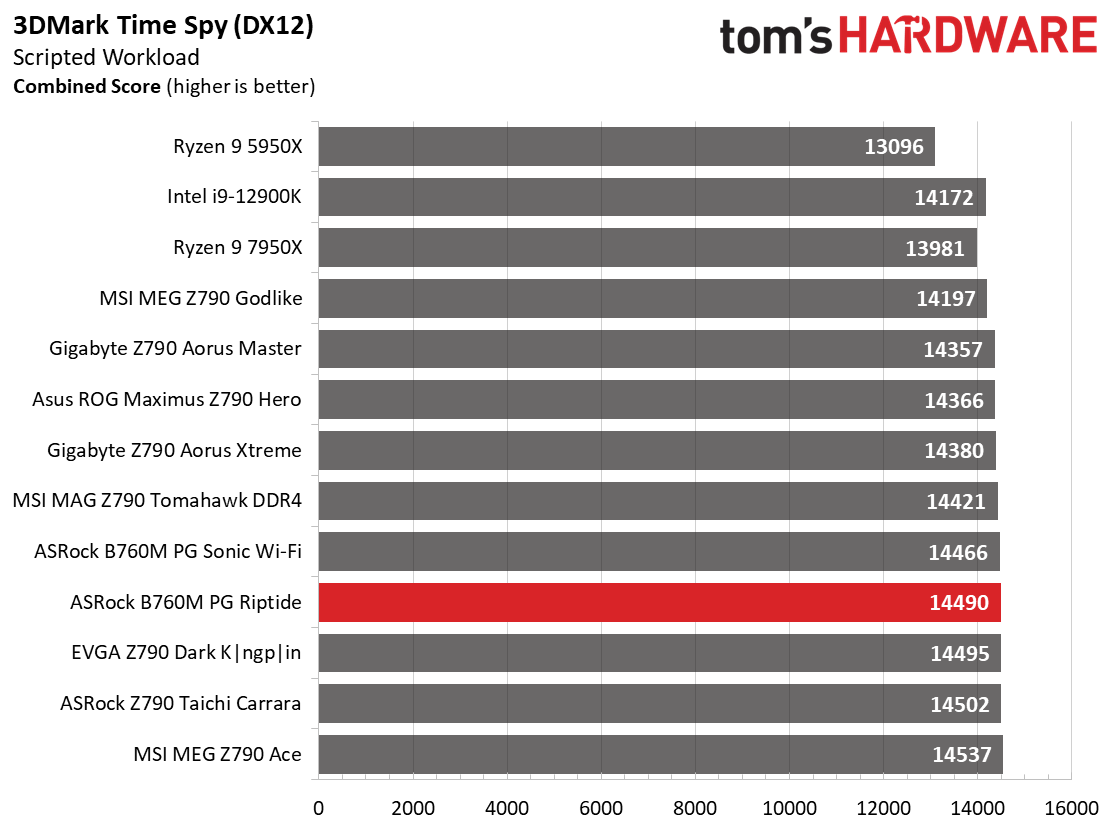


Starting with the launch of AMD’s Ryzen 7000 platform, we’ve updated one of our games, F1 21 to F1 22, while keeping Far Cry 6. We run the games at 1920x1080 resolution using the Ultra preset (details listed above). As the resolution goes up, the CPU tends to have less impact. The goal with these settings is to determine if there are differences in performance at the most commonly used (and CPU/system bound) resolution with settings most people use or strive for (Ultra). We expect the difference between boards in these tests to be minor, with most falling within the margin of error differences. We’ve also added a minimum FPS value, which can affect your gameplay and immersion experience.
On the other hand, Gaming results were average to above average among our tested samples. 3DMark results were average, while the actual game tests were some of the fastest results so far. It may be slow with heavy CPU use and productivity-type tasks, but it’s a more than competent gamer with these titles.
Overclocking
While the B760 chipset for Intel doesn’t generally allow users to overclock the processor this board does have a BCLK generator, and we got our system to 5.6 GHz and 4.4GHz (P and E cores, respectively), setting the BCLK to 102. We set the voltage to 1.35V, unlocked the power limit, and off we went. Since we used much less power in this manual configuration, the system handled it well, including the power delivery. Unlock the power limit and let it run by default. You’ll get all kinds of thermal throttling of the processor and, eventually, the power delivery, as it’s incapable of sustaining that much power without active cooling.
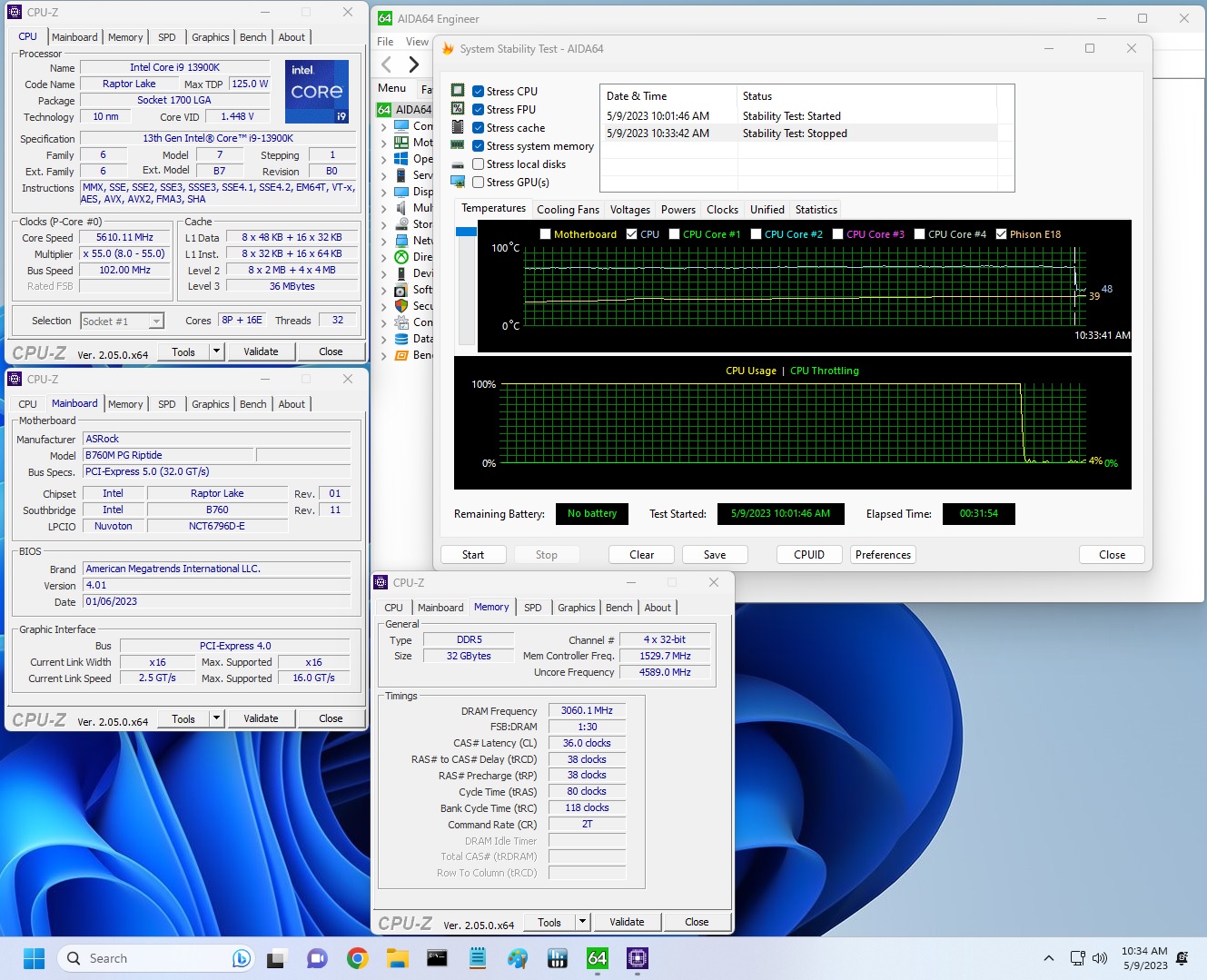
The board had no issues running the two RAM kits we tested at speeds up to DDR5-6000. ASRock lists support up to DDR5-7200, but we used our DDR5-6000 for overclocked testing as most users buying a budget board won’t reach for the faster options. The kit passed our stress test without flinching. Your mileage may vary as reaching these speeds depends on the memory kit. Stick with the QVL list for the best chance of achieving the highest supported speeds.
Power Consumption / VRM Temperatures
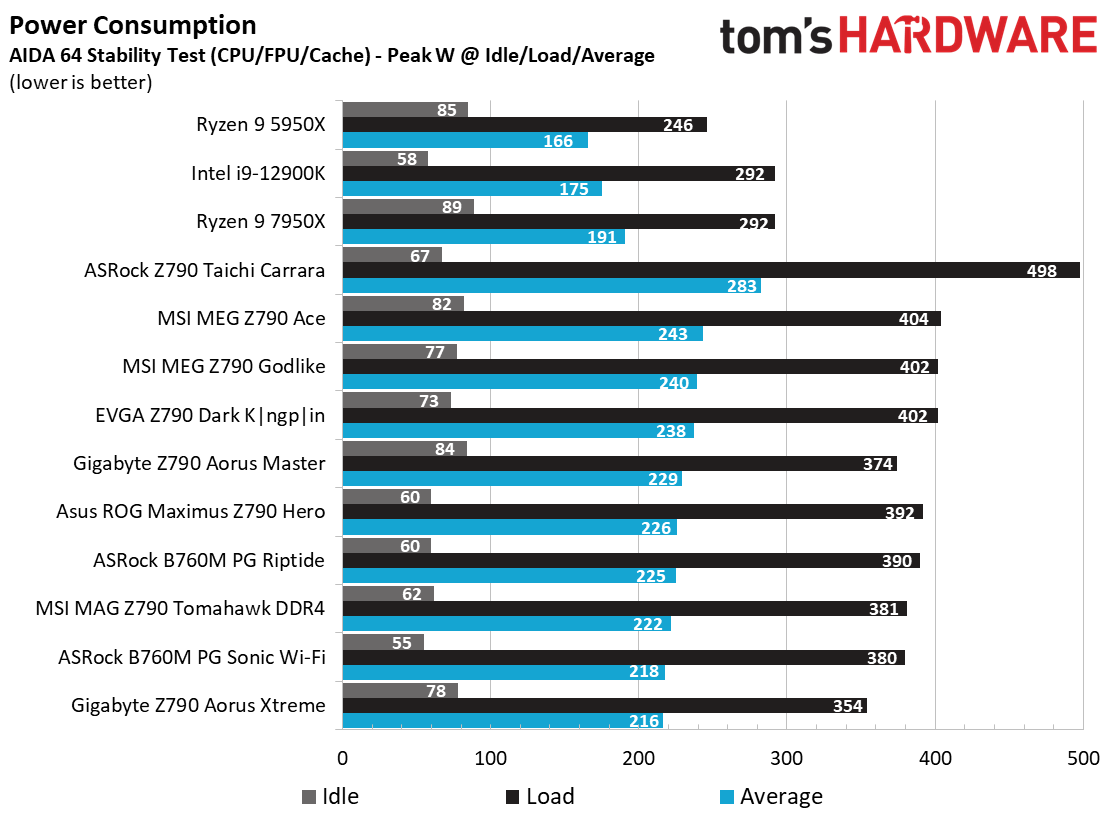
We used AIDA64’s System Stability Test with Stress CPU, FPU, Cache and Memory enabled for power testing, using the peak power consumption value. The wattage reading is from the wall via a Kill-A-Watt meter to capture the entire PC (minus the monitor). The only variable that changes is the motherboard; all other parts remain the same. Please note we moved to use only the stock power use/VRM temperature charts, as this section aims to ensure the power delivery can handle the chip even when overclocked. Since we’re using less power to get more clocks, those datasets are more novel than useful. We’re also temperature limited on the processor, so adding more power isn’t possible without increased throttling.
Idle power consumption on our B760M PG Riptide peaked around 60W at the desktop, which is one of the lower values we’ve recorded. Peak power reached 390W, or around the average for the chip/platform in our testing. After the Intel turbo kicks in and reduces the clocks/voltage, power peaks around 220W with the CPU locked to 125W.
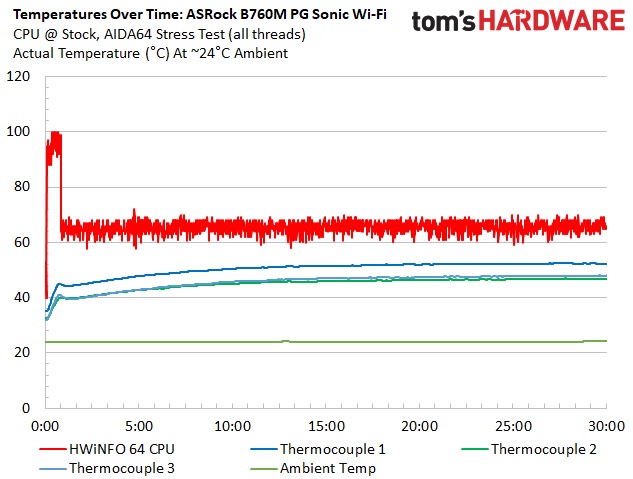
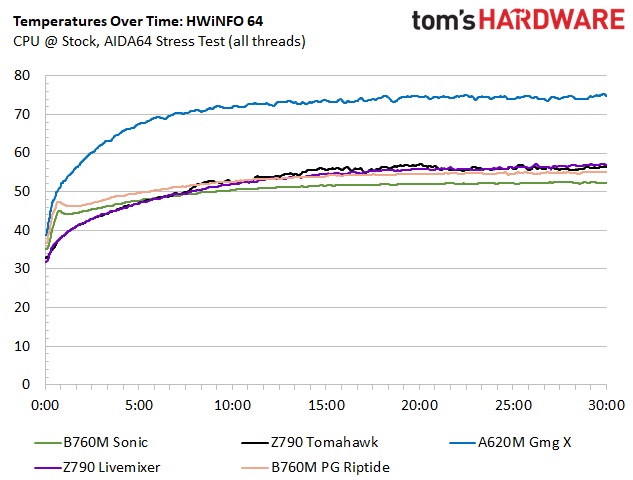
VRM temperatures on the PG Riptide, like the Sonic board, don’t have a chance to heat up much, considering the low 125W limit imposed under a minute into testing. The board wants to get hot fast when running the PL2 limit of 253W. Temperatures during our testing were fine, but the power delivery heats up if you manually raise that PL1 limit and leave the Vcore alone. If you push a high-end processor in this board, you can lower the Vcore to help with thermal throttling and performance issues.
Bottom Line
If you’re in the market for an inexpensive motherboard and don’t need all the bells and whistles the new chips and platform offer, like PCIe 5.0 capability, a B760 board is the way to go. The B760M PG Riptide has everything you need for a smart mainstream system. There are two M.2 sockets and four SATA ports, 2.5 Gb networking (available Key-E M.2 socket for an adapter), a budget audio codec, and power delivery capable of handling our 13900K. It also looks good for such a cheap board and includes RGB LEDs. Performance out of the box is limited to Intel’s spec, so it can limit long-running and heavily multi-threaded activities. You can make some manual changes, such as adding more PL1 power and lowering the Vcore, bringing it back up to par. In short, this is a well-rounded, fair-priced option among its peers, but make sure you understand how you use your system to get the most out of it.
Regarding the competition, Gigabyte has a B760M Aorus Elite AX ($169.99), while Asus has a Prime B760M-A board for $153.99. Gigabyte’s standout feature is the 20 Gbps Type-C port and the contrasting black and grey appearance (also with integrated RGB lighting). Meanwhile, the Asus doesn’t have much, if anything, over either of these boards (and doesn’t have integrated RGBs). MSI’s Pro B760M-A Wi-Fi DDR4 ($169.99) is the most expensive. However, it supports DDR4, so the overall cost to get into the platform is less as DDR4 is still cheaper to buy. It also has integrated Wi-Fi, while that costs extra on the other boards.
Ultimately, The ASRock B760M PG Riptide is easy on the wallet, handsomely featured, and looks good for the price. You don’t get PCIe 5.0 hardware or faster than 10 Gbps USB ports native to the platform, but neither does the competition (MSI has 20 Gbps Type-C, but no PCIe 5.0). A great selling point for this board for overclockers is the integrated BCLK generator, which allows for additional headroom so you can overclock the locked chips. So long as your new system doesn’t require ultra-fast USB ports, or PCIe 5.0 anything, the PG Riptide is the pick of the litter, and it costs around $20 less than its direct competitors.
MORE: Best Motherboards
MORE: How To Choose A Motherboard
MORE: All Motherboard Content







